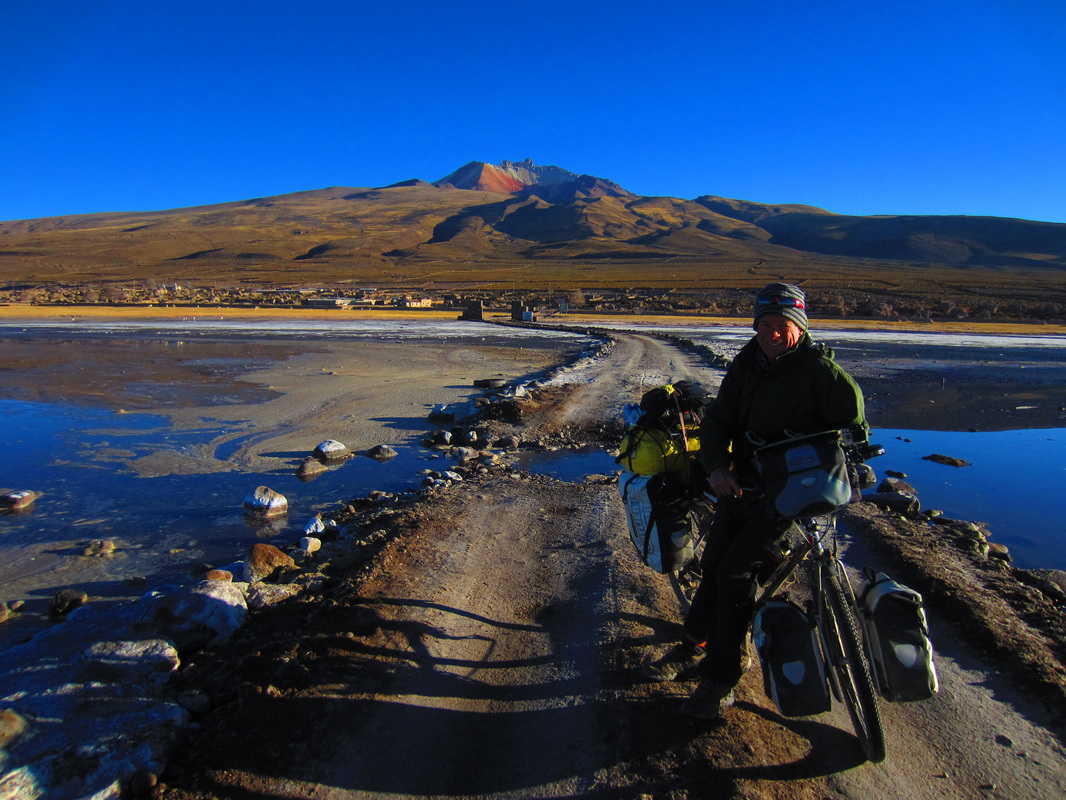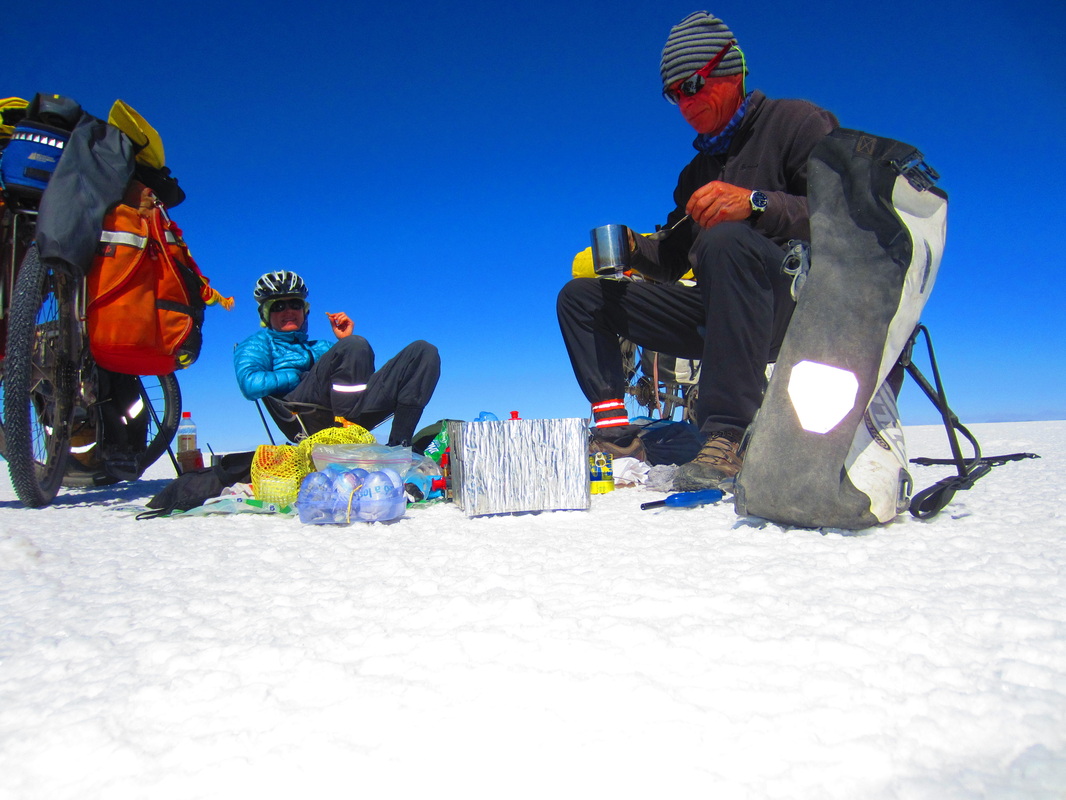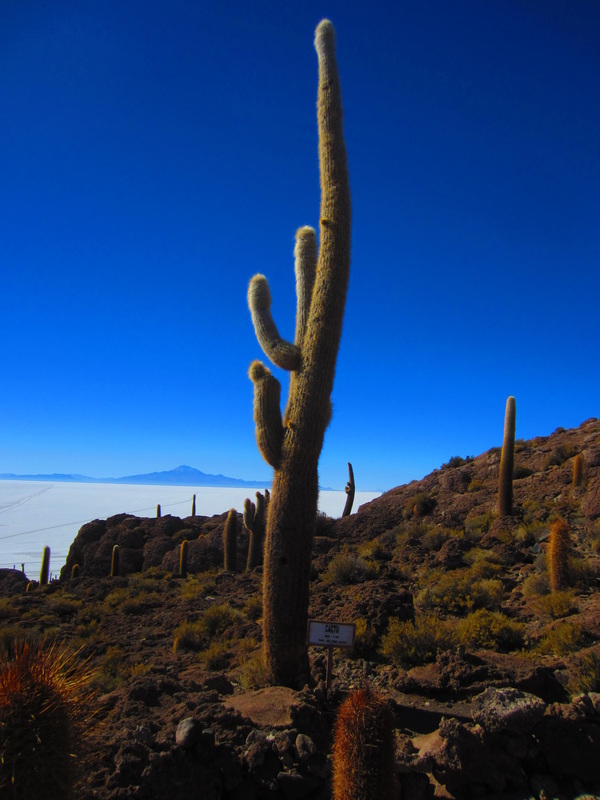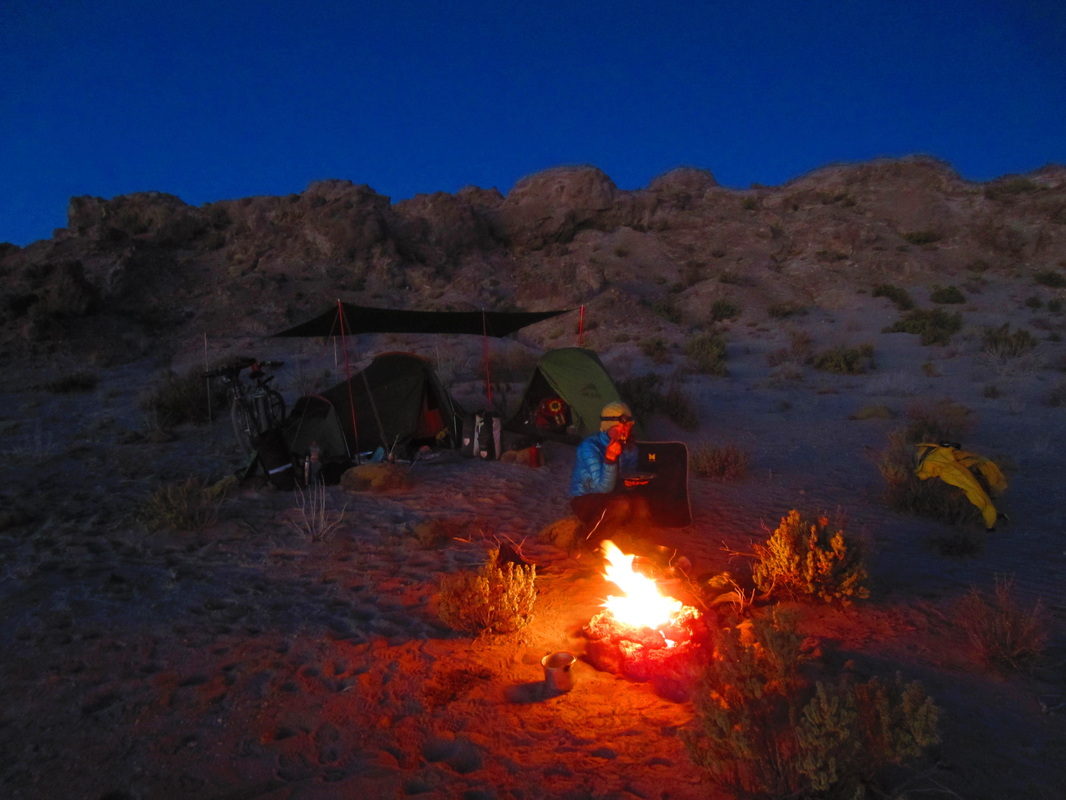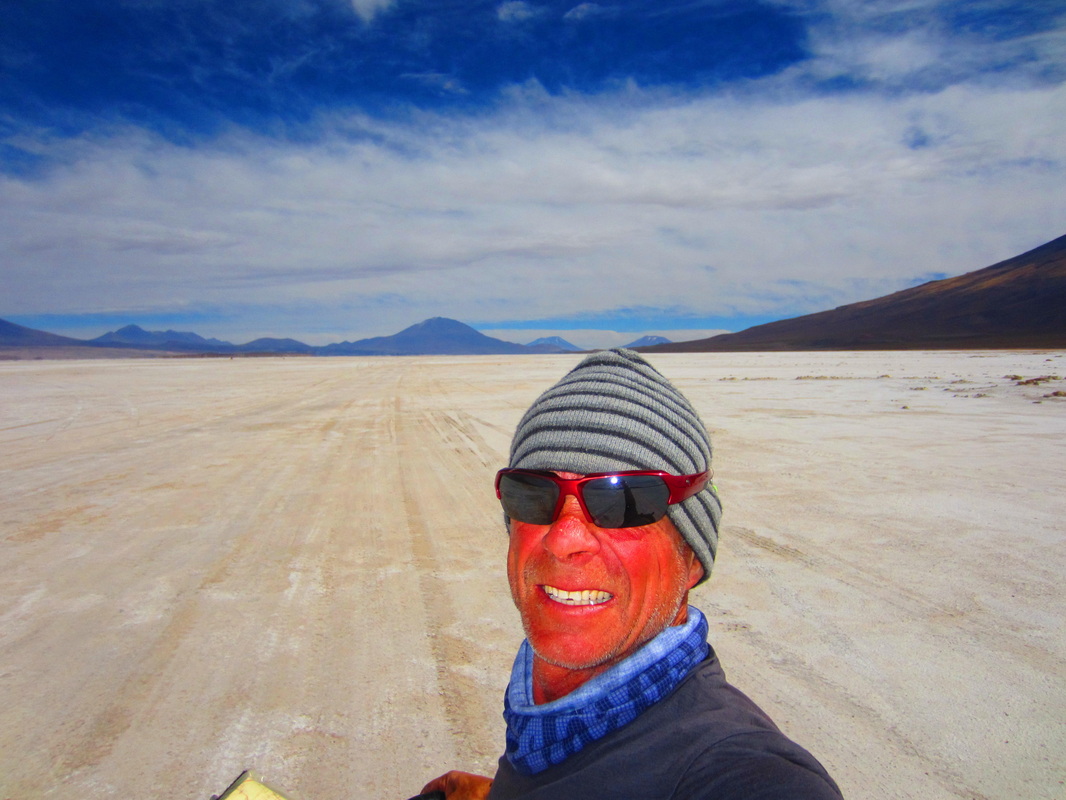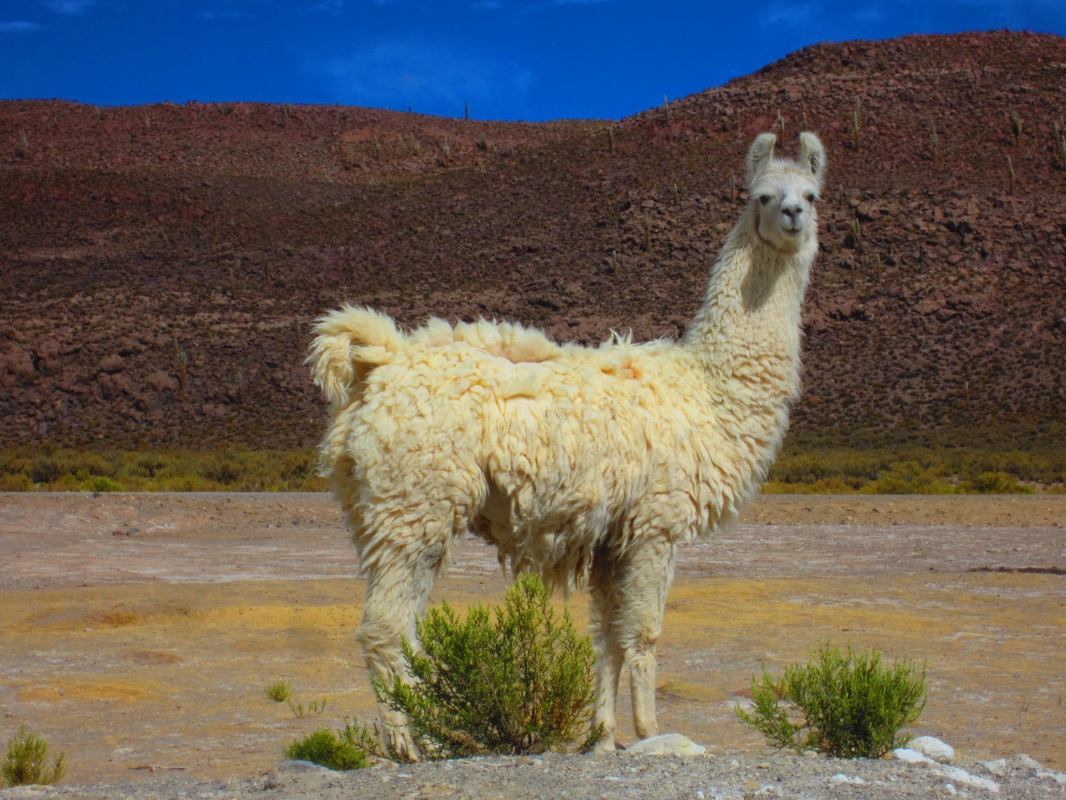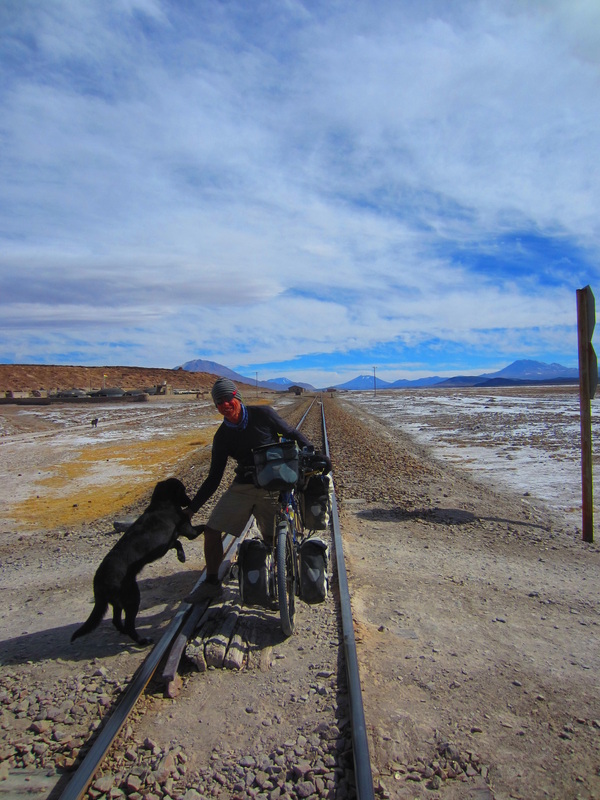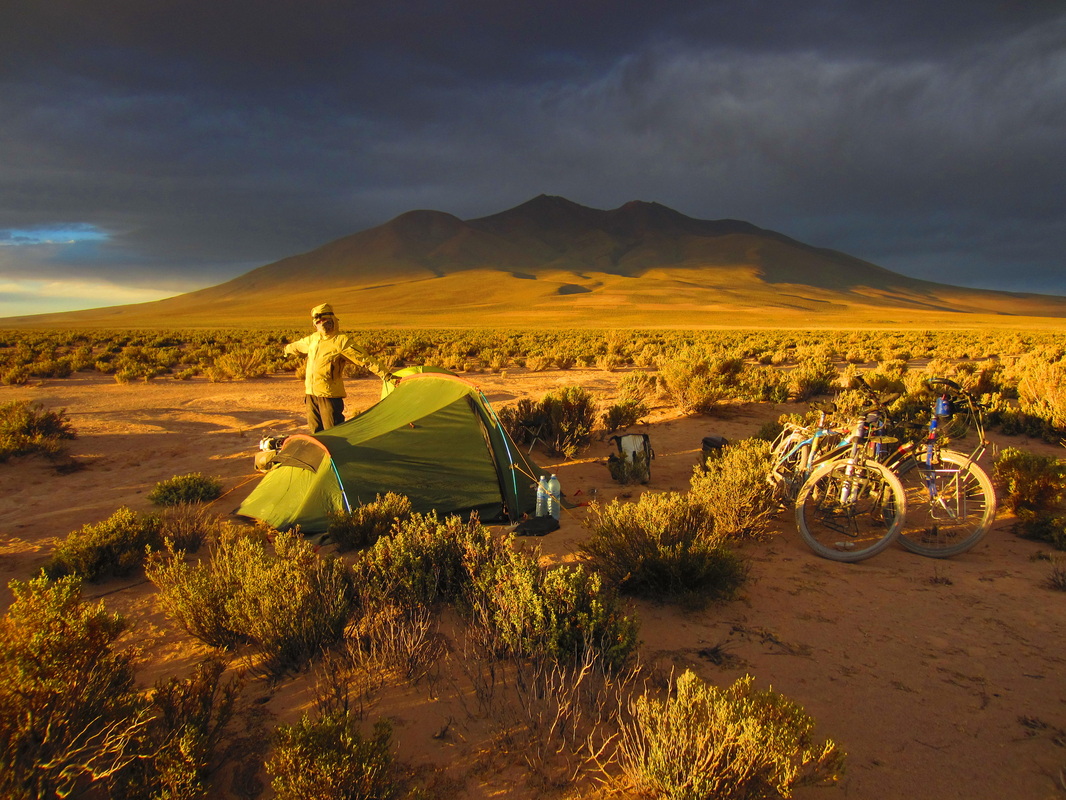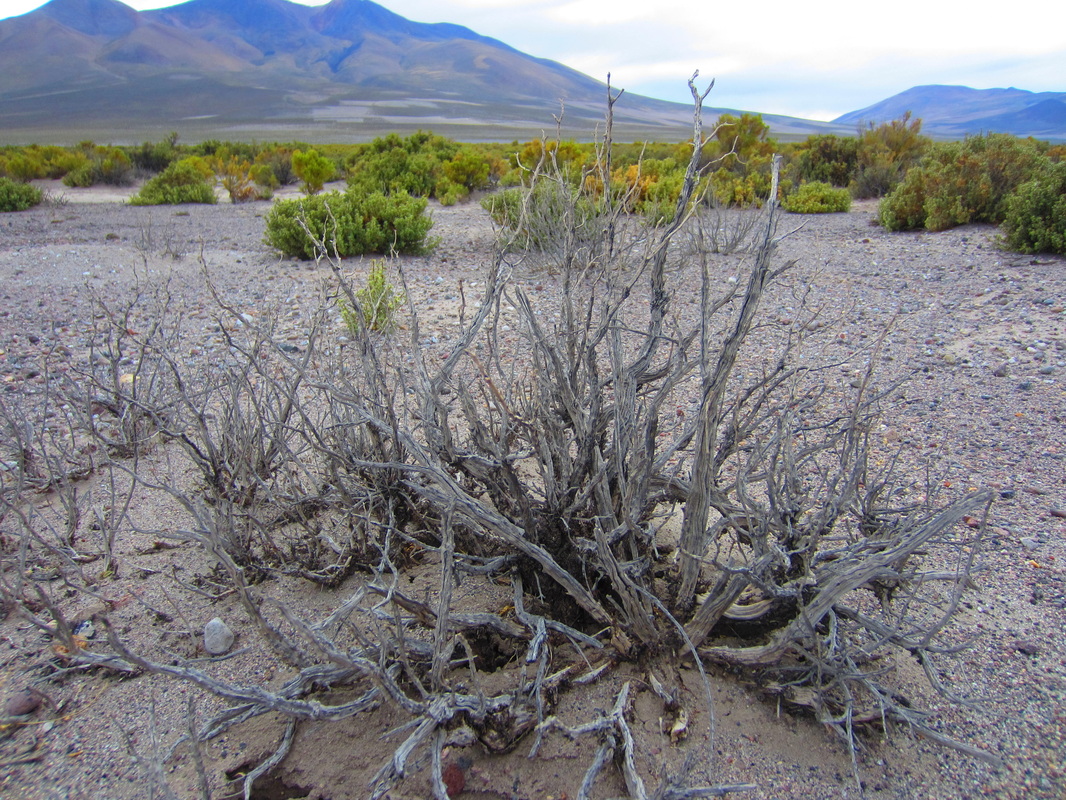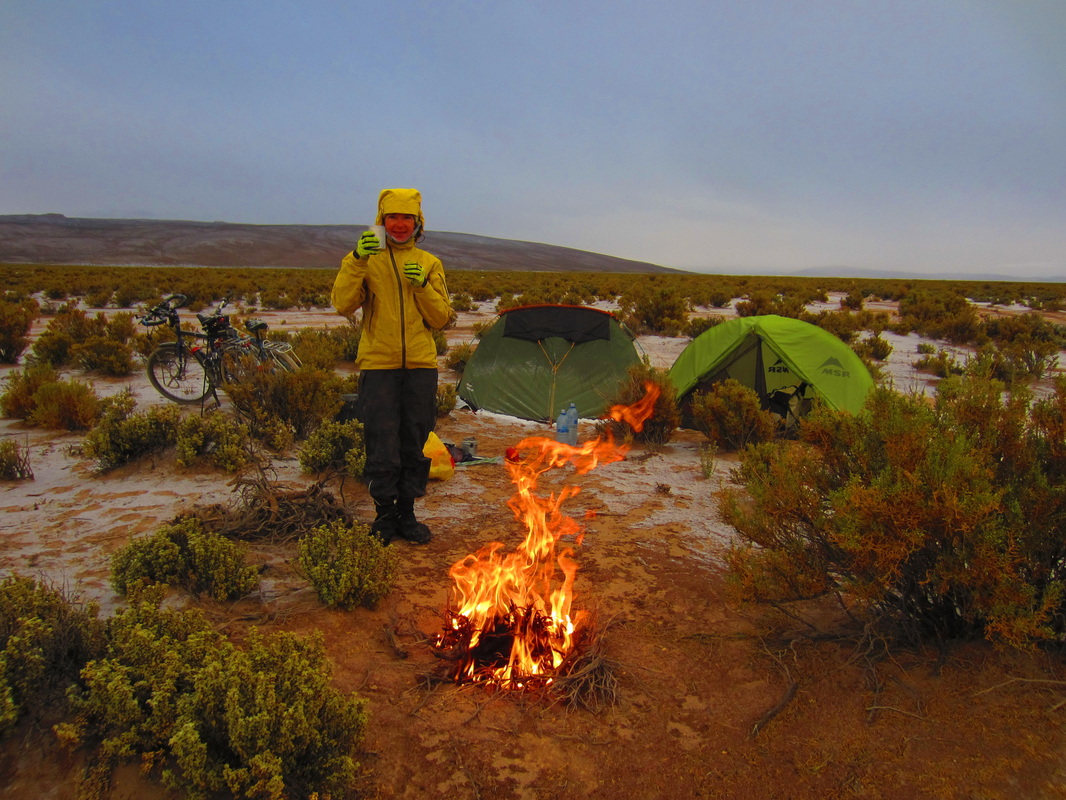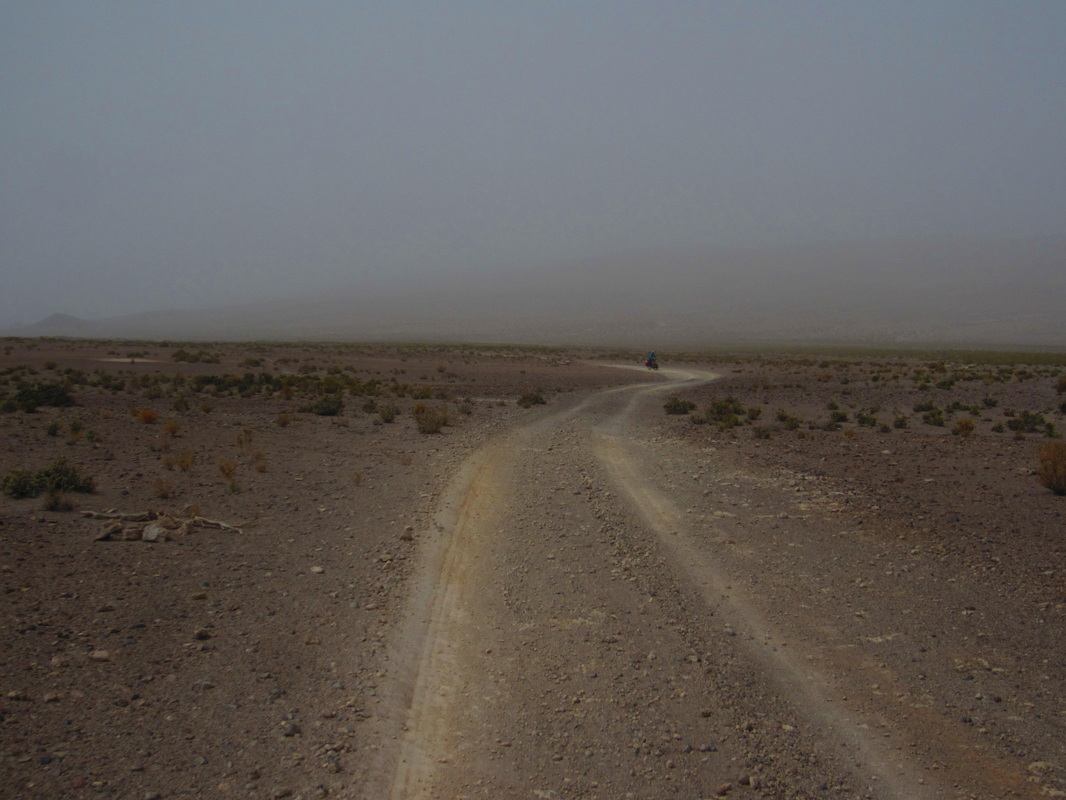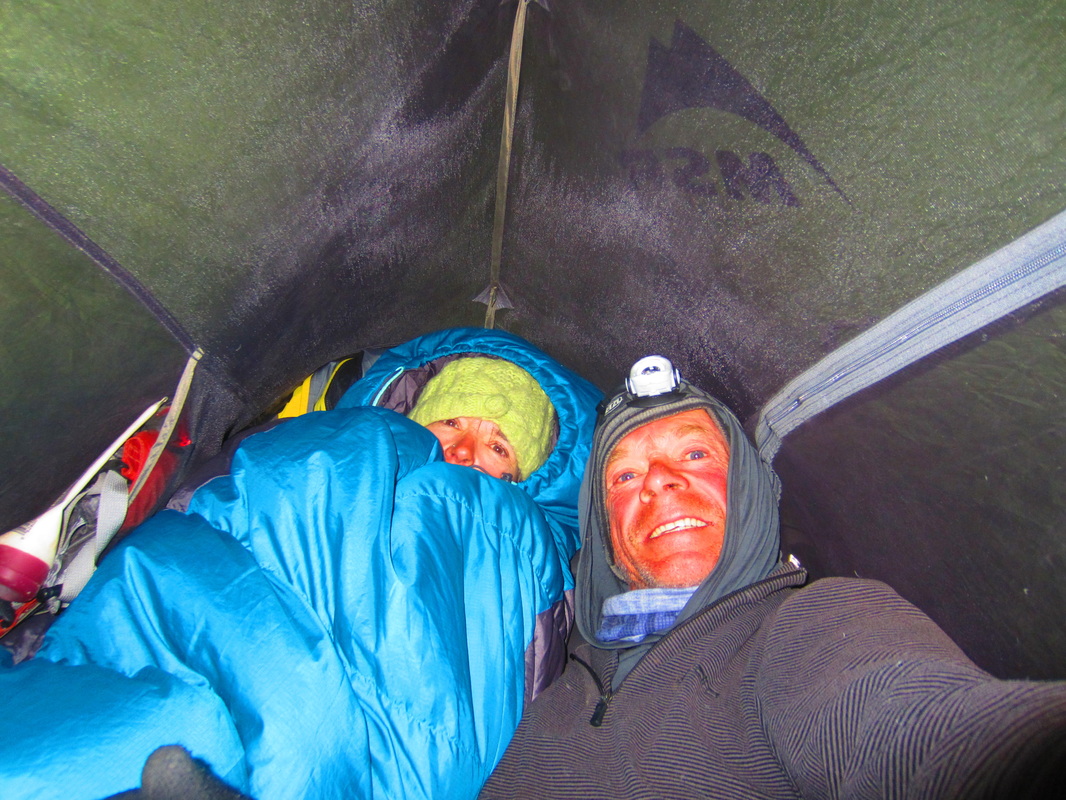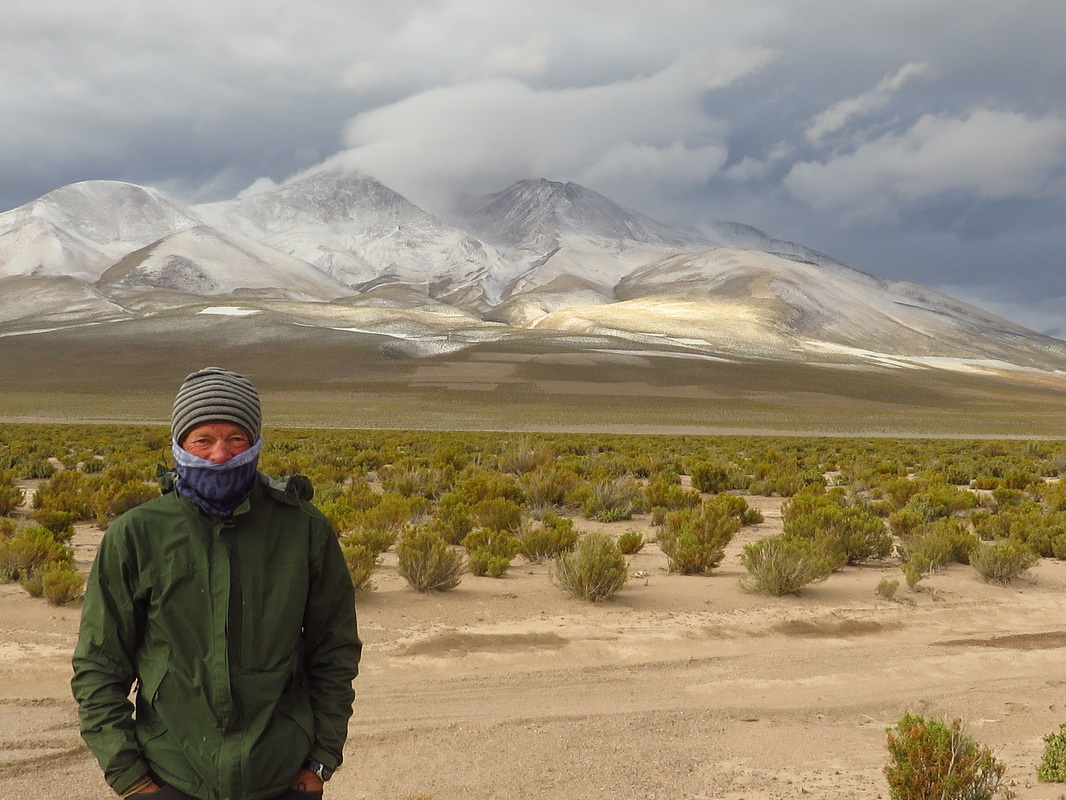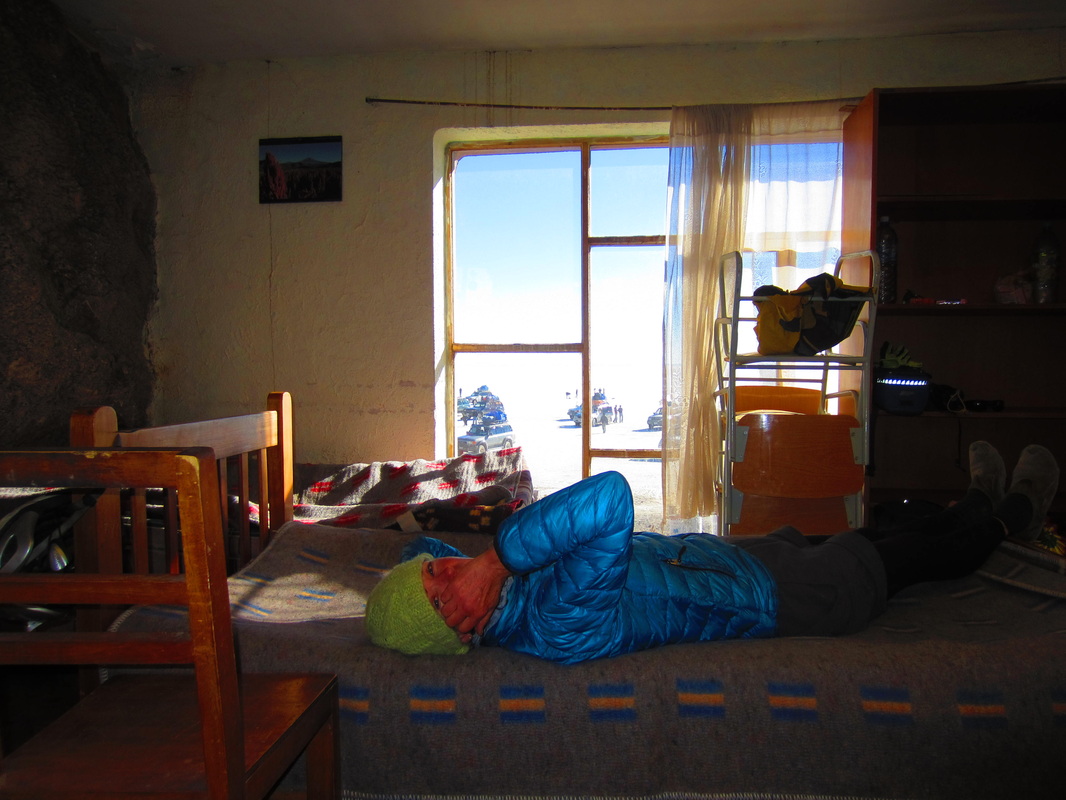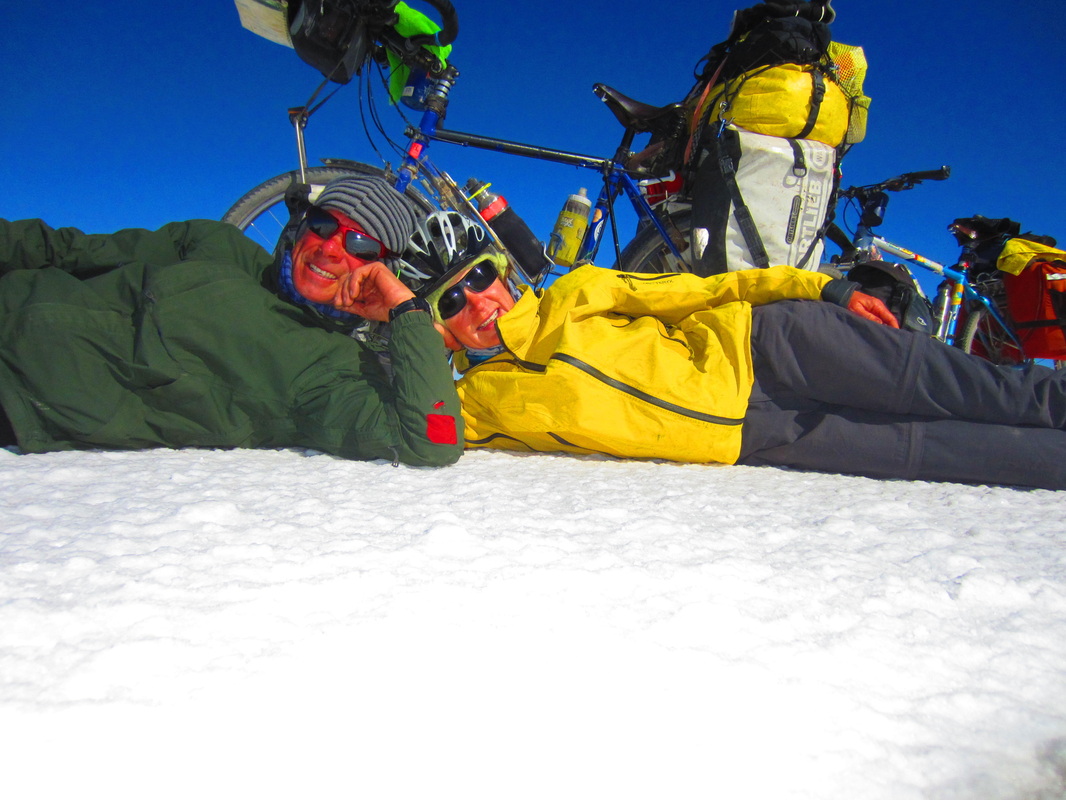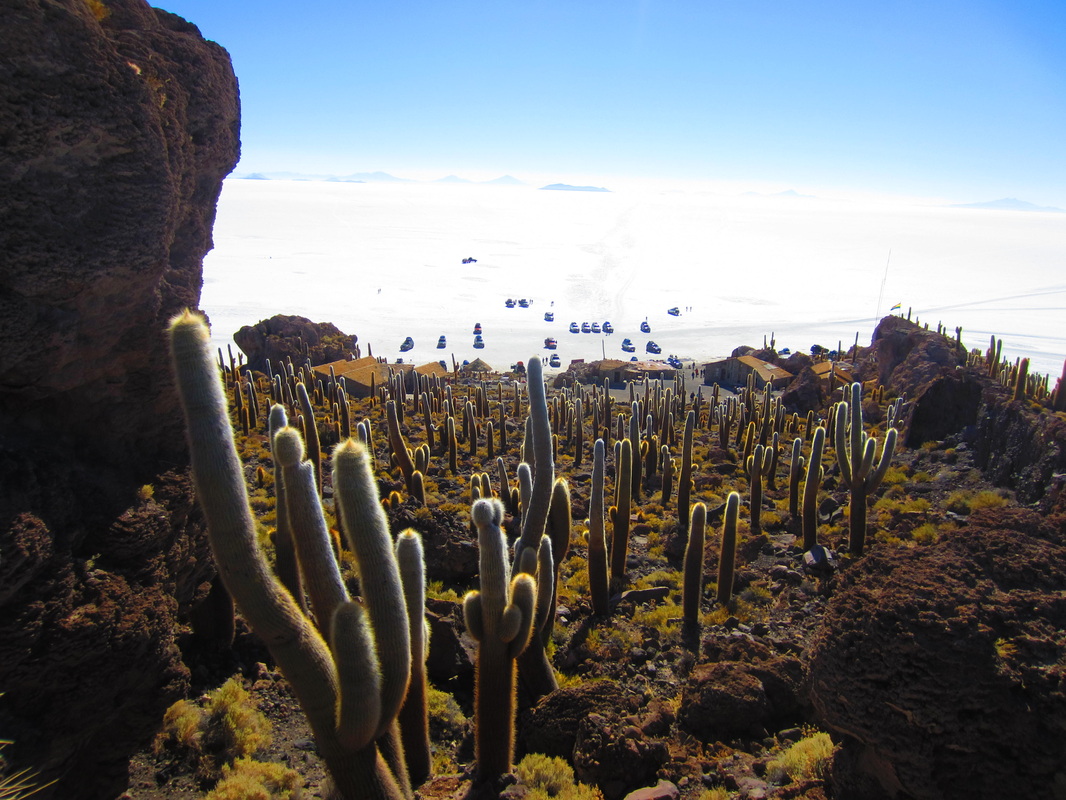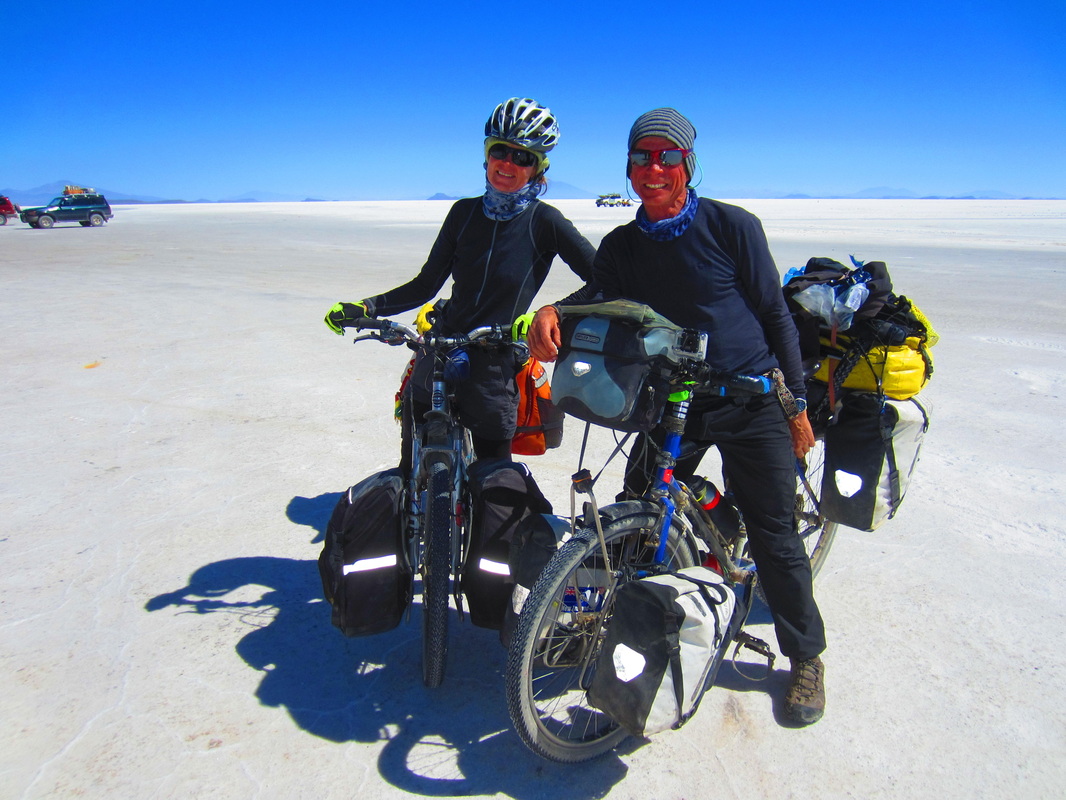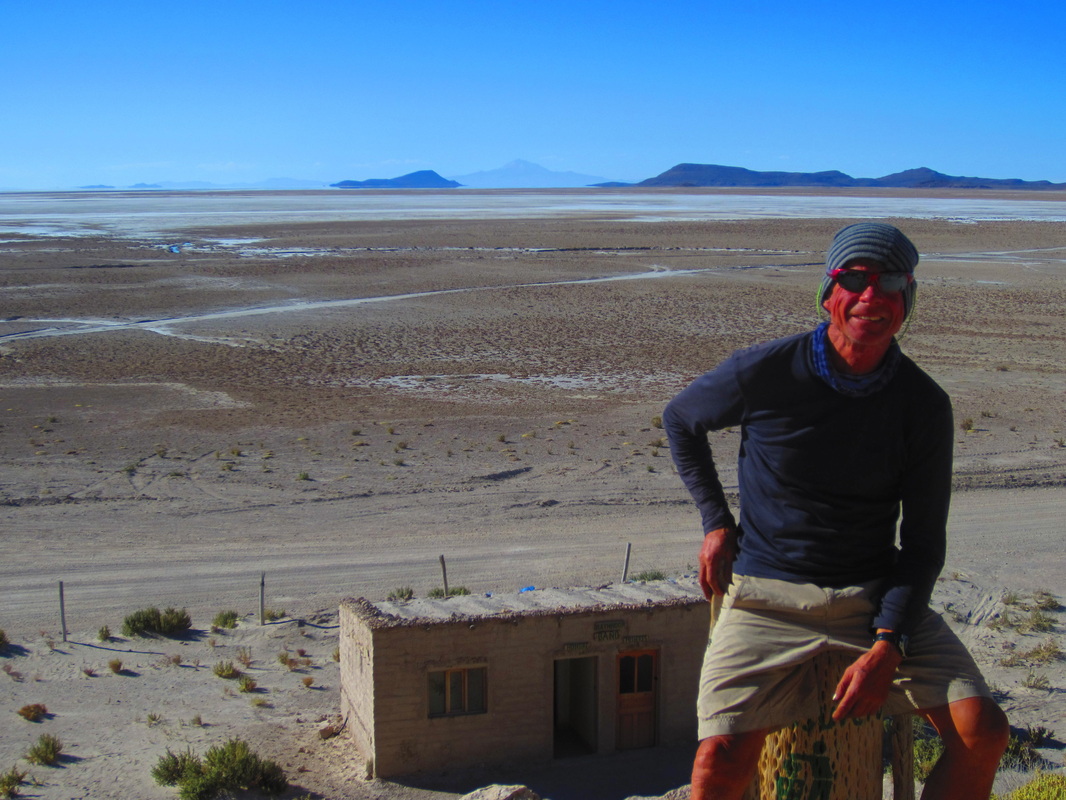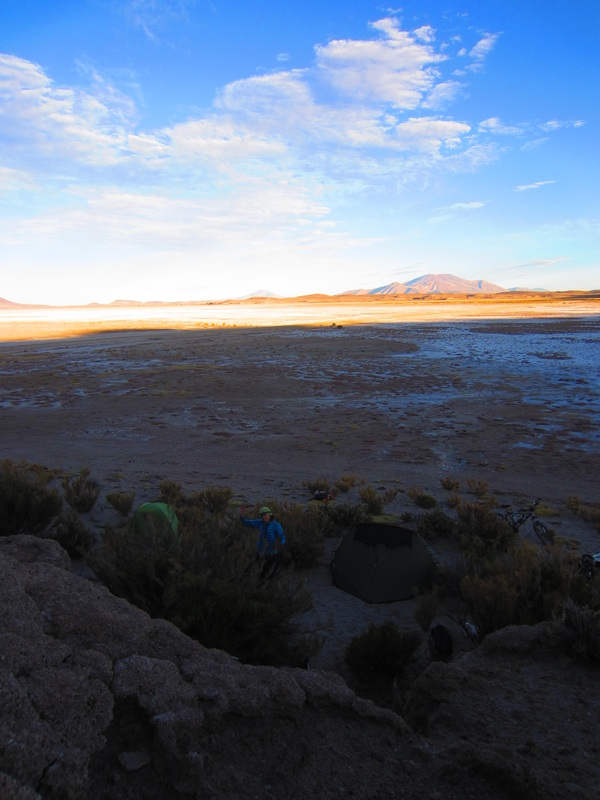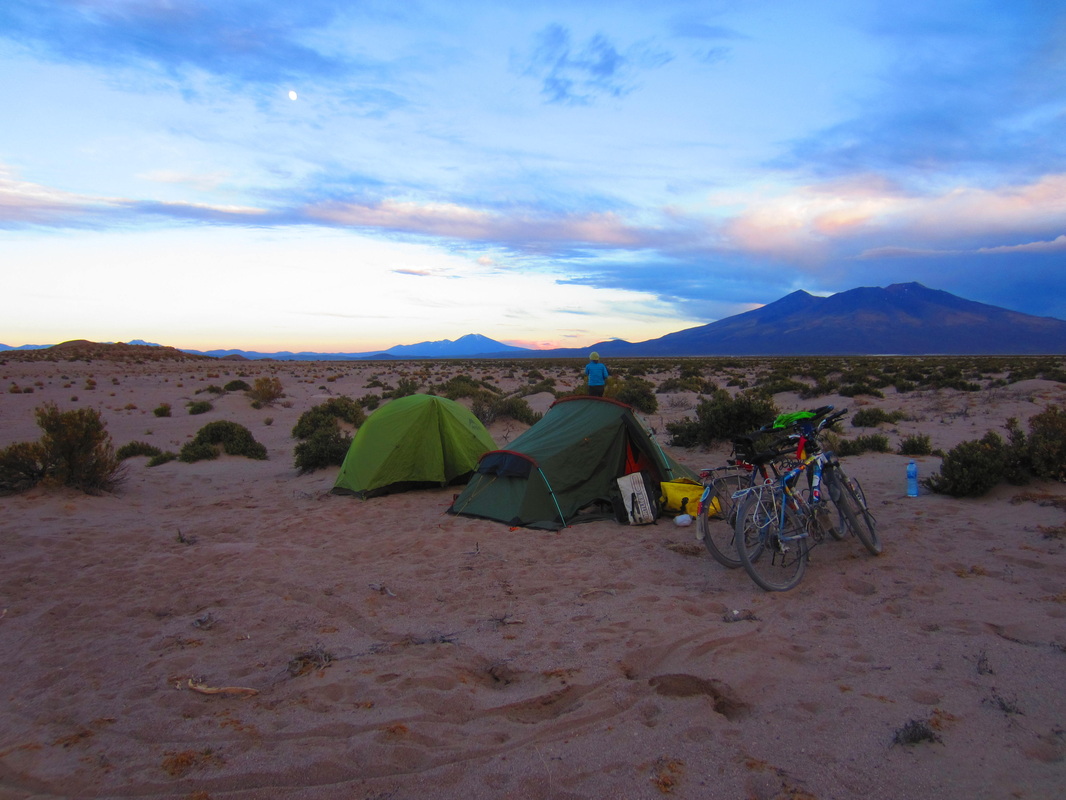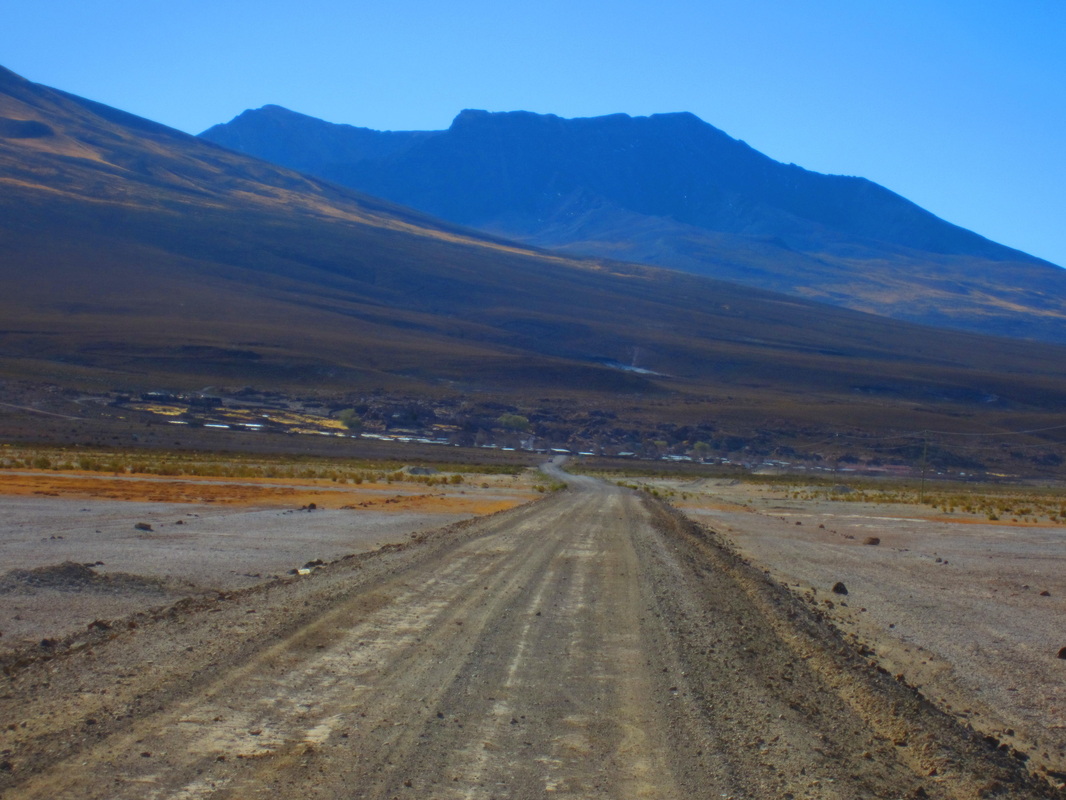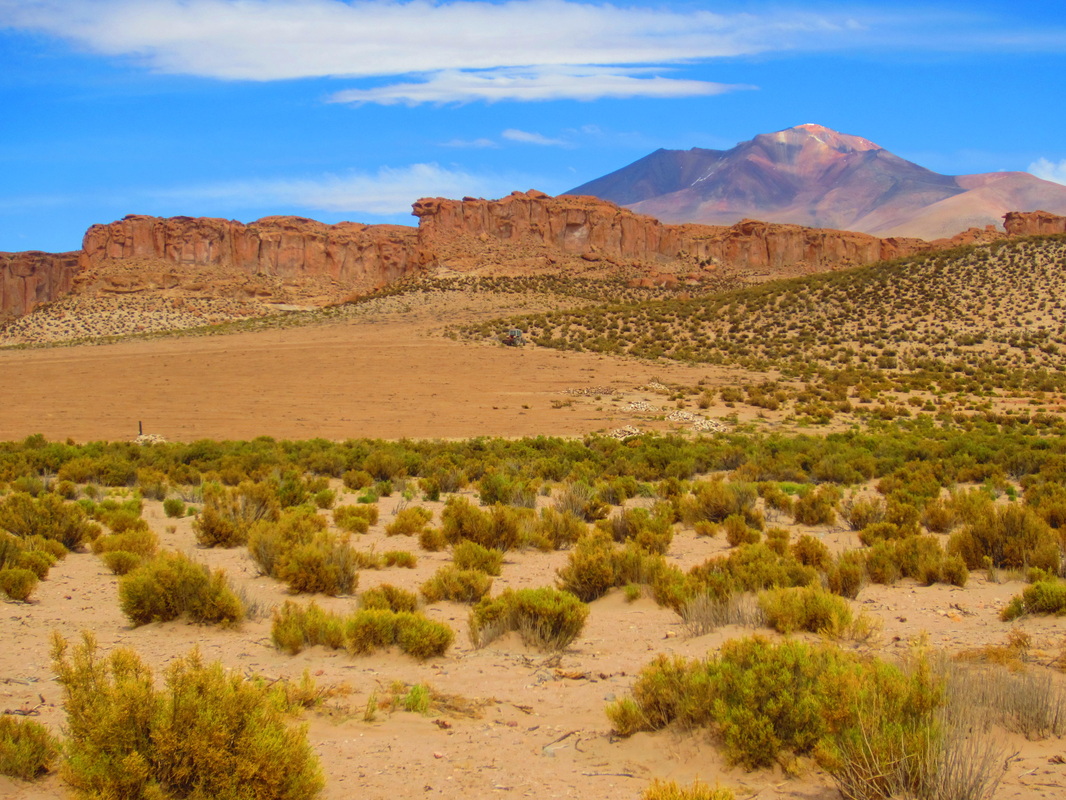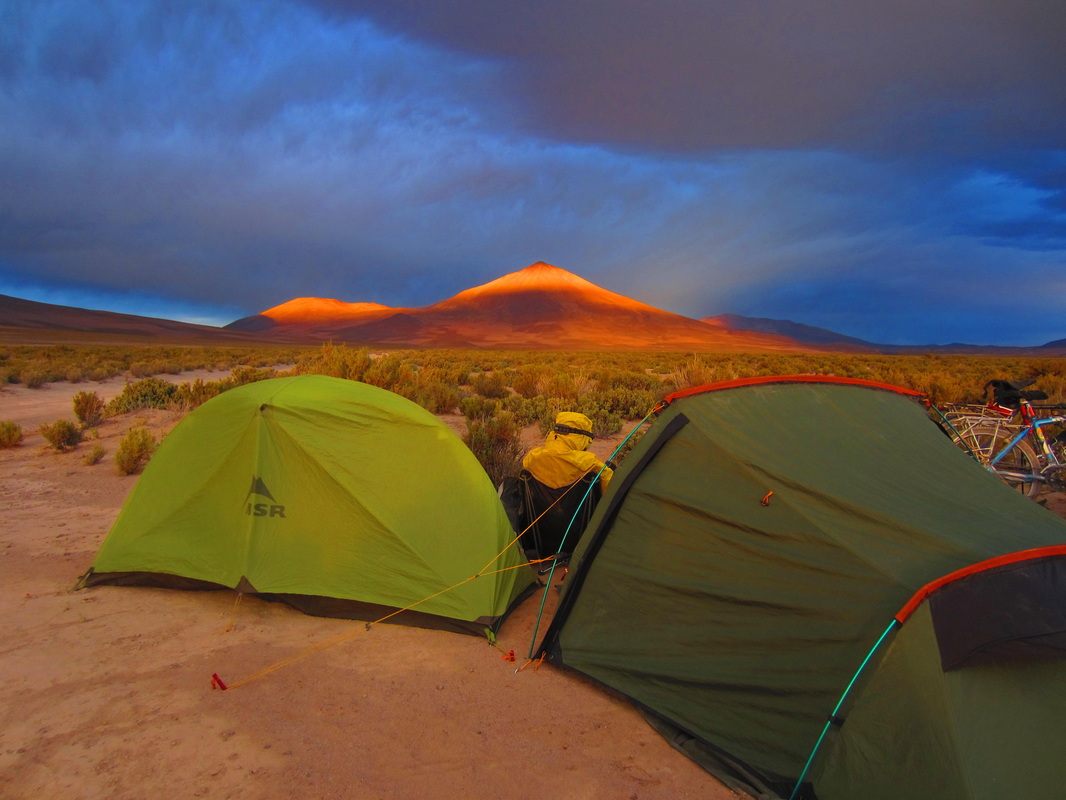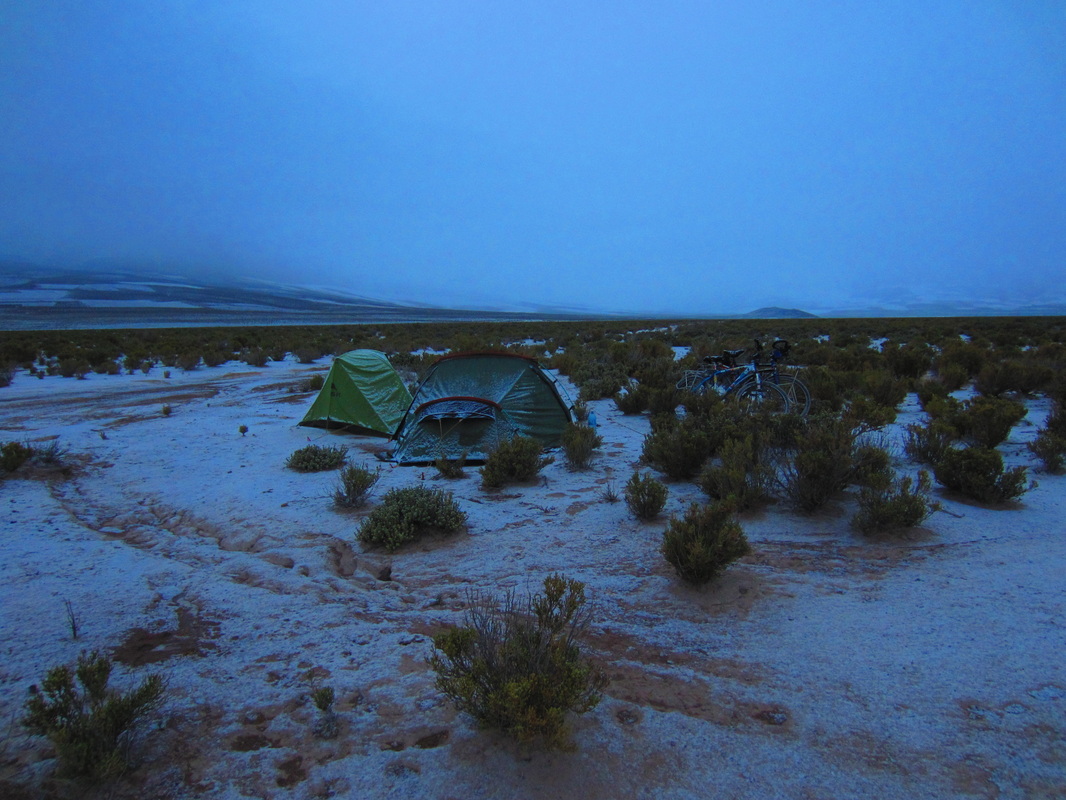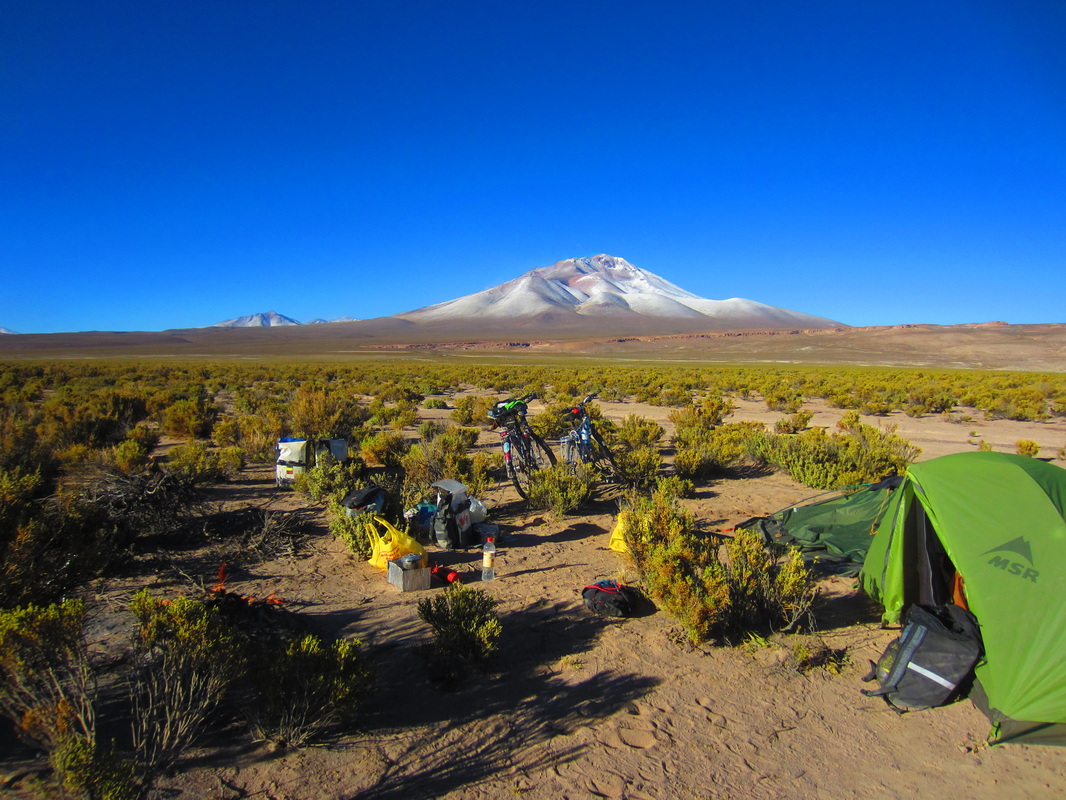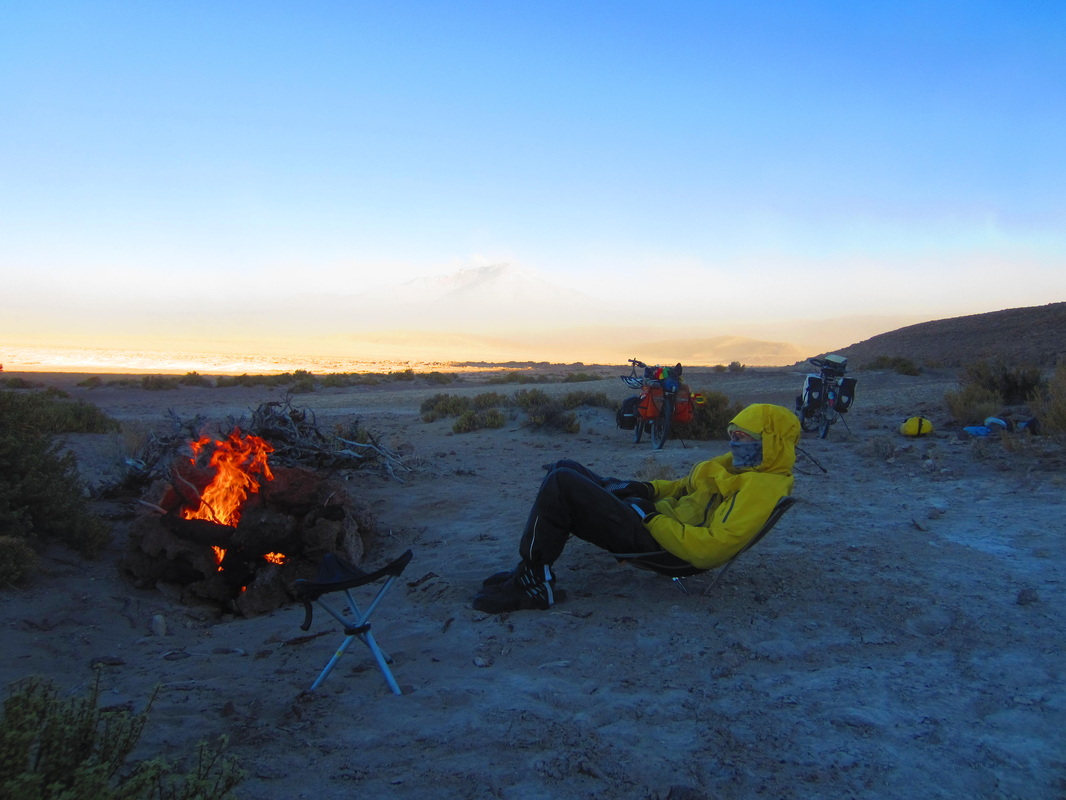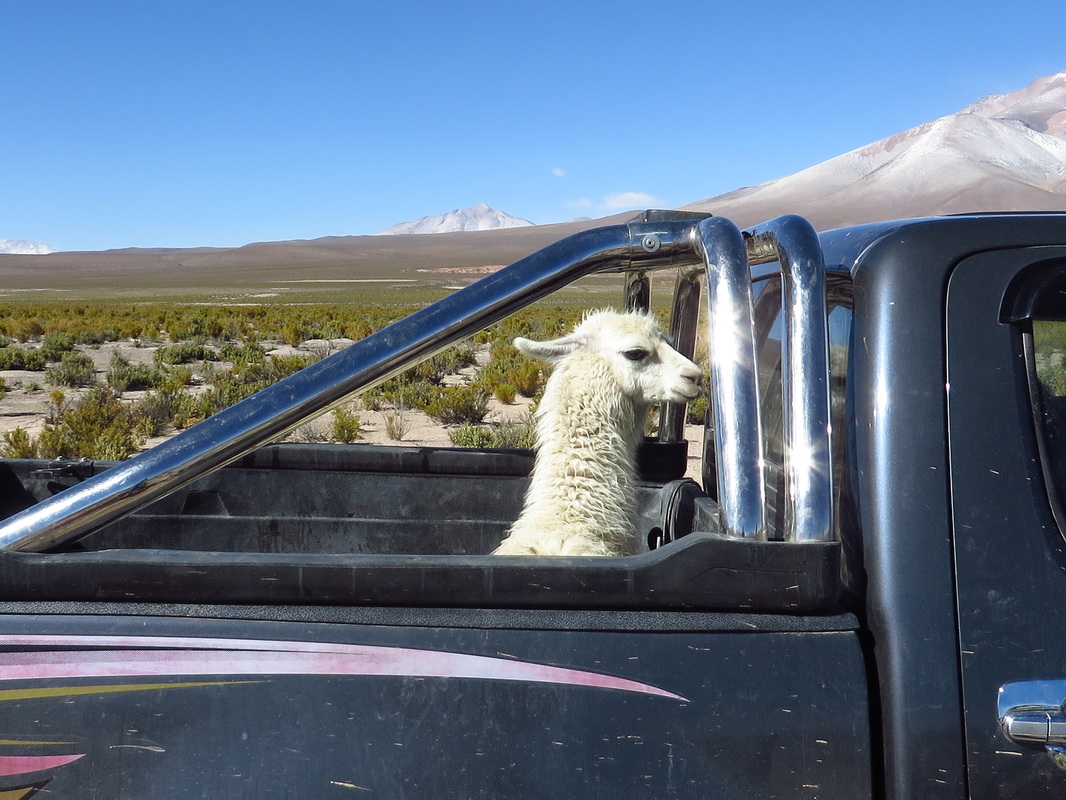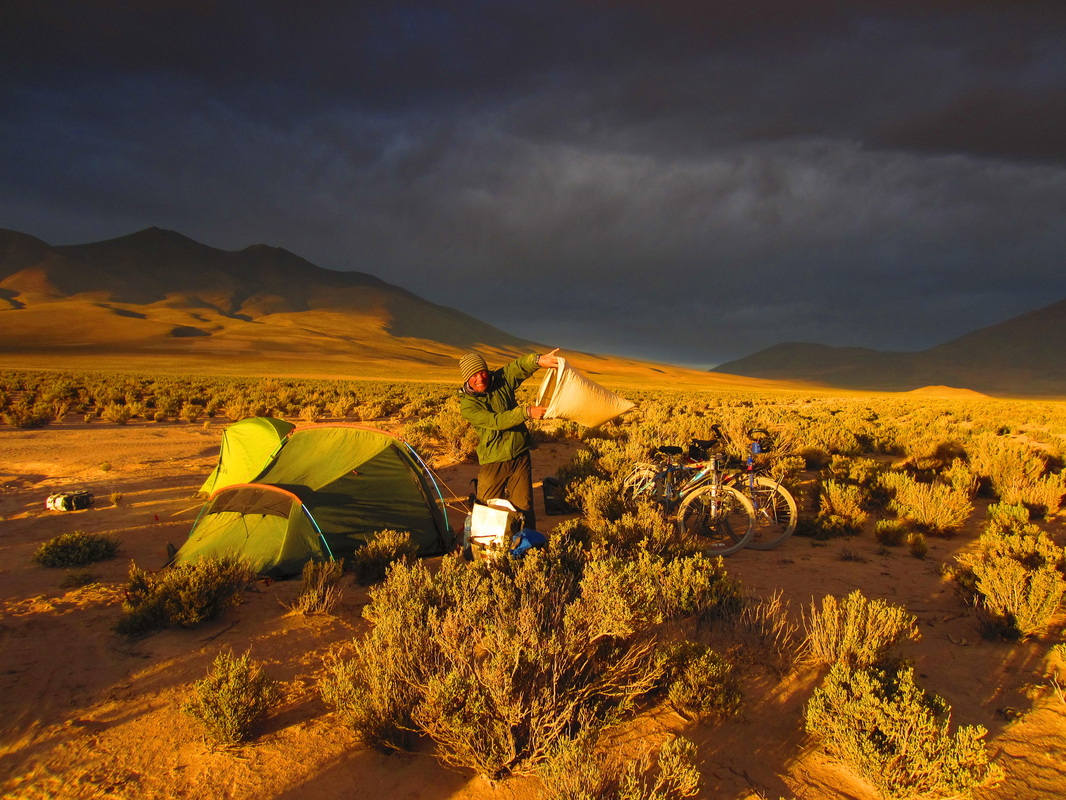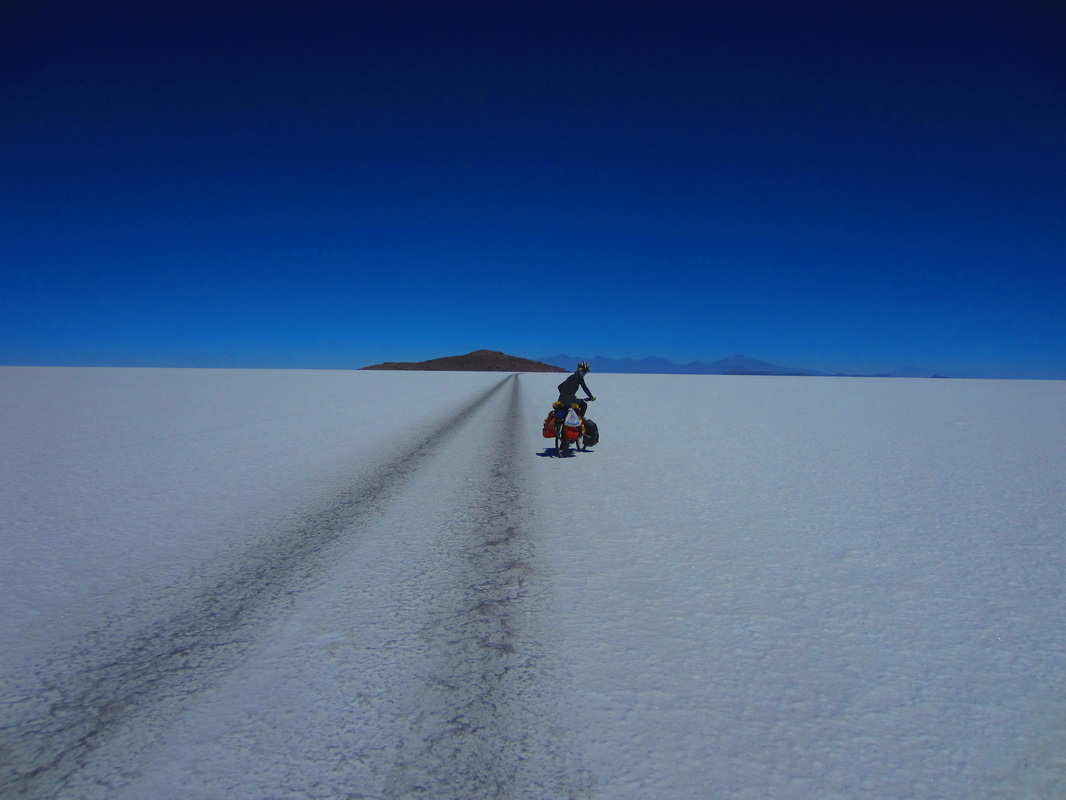14/8/2013 Challapata to 6km
sth of Santuario de Quillacas,
Camping under a bridge
alongside Rio Marques
D64, T6, Av16, Max42, Tot
17715, 8548
Last night we met a guy and
his wife travelling from Brazil in their vehicle.
He was a farmer of Belted
Gallaway cattle. An interesting person.
We gave him directions to the
Victor.
In the morning we were in no
major hurry to leave and finally got away about
1000.
In Huari we had orange juice
bought more bread and I enjoyed lamb and beef deep fried.
It was such a laid back town,
so common here in Bolivia. Though not as vibrant as the small Peruvian towns,
they have this lovely easy nature about
them.
There are always women on the
main corner doing chicharrone and other breakfast dishes, men squeezing oranges,
small road side mobile tiendas selling nibbleys and groups of people just
chatting.
Dogs, though not many are
always close at hand.
People in these places are
always friendly, at breakfast the woman asked me if Deirdre was my wife. I said
no, they said did we sleep together, my comments started a good round of
laughing and further joking, they were fun ladies, always in their aprons.
I asked them where their
husbands were, one was single and the other said hers was working.
I suggested they were at home
sleeping. It was a good enjoyable time for half an hour.
We took the road to Condo
which was gravel to there, and back to the main
road.
My stash of fresh roasted
peanuts was lost on the incredibly rough road, had it not been slightly
downhill it would have almost been unrideable.
Once on the main road to
Quillacas and on to the Salar, it was the altiplano at its most majestic.
We now had no ranges close to
us, it was mirages in most directions. We could clearly see Lago Poopo.
The colours presented to us
ranged from the black road, yellow tussocks, cream ground level grasses, light
brown sands, darker brown adobe dwellings, bluish ranges, brown valleys in the
ranges, a cloudless deep blue sky and on many occasions llamas of all shades of
white, brown and black.
The llamas were very
prevalent after Carainacha, they
were in large herds and were fairly quite when
approached.
The road was dead straight for
miles.
Vegetation now was just a
ground level herb like grass, the llamas were obviously fond of it because if
they weren’t, the only other option was to eat sand.
Deirdre was ahead of me at a
time when a small lake fringed with salt was passed on my left.
On the lake half a dozen pink
Flamingos were scooping the saline water.
For me it was quite a thrill
to see these extraordinary birds in their natural habitat.
A friend in Rhode Island had
given me a monocular a couple of years ago, it has been in my front pannier for
all that time not being used. Today it was invaluable too closely look at these
few birds.
Up ahead was the town of
Quillacas, here we stopped for water and a rest.
Again joking and talking with
apron wearing middle age woman at a
tienda.
From here we just cruised
along with the idea of finding a camping spot pretty
soon.
The landscape was still
featureless though definitely possessing an undeniable beauty.
It was quite mild as we were
far from any ranges.
Incidentally, much land earlier
on had been cultivated, obviously for Quinua, leaving Challapata, we saw the
storage silos for the seeds.
Again on a dead straight
elevated road, only newly constructed with a surface of fine gravel we came to a
bridge spanning a riverbed with a reasonable flow of water in it.
Not overly polluted from first
impressions I might add.
This was a perfect camping
spot in this otherwise lonely landscape.
There
was a track to the river, low and behold like a couple of hobos we set up camp
under the bridge.
A favourite spot for people to
dump disposable nappies.
Setting up camp and having a
much deserved coffee and tea we went for a stroll, just before sun down.
The colours of the late day
were something else, the ranges to the east were brilliantly lit, the ground
glowed a yellow, there was one lonely tussock clump by the river.
A species of dwarf Cypress was
also present.
There were
plants that looked like coral scattered about, in their vicinity were
small burrows of an unknown rodent, possibly.
It was a special time of day
to be wandering on the altiplano.
We both bathed in its
uniqueness and beauty.
Dinner was soup, bread,
tomato,and onion on crackers and the obligatory coffees and tea with sweet
biscuits.
We were both in bed early and
as usual, when I have battery power I type the day’s proceedings while fresh in
my mind.
15/8/2013 Rio Marques to
Jayoqota
D52, T6, Av14.26, Max54,
Tot17767, 8600
Our coldest morning
yet
I was awake about 0630, there
was a strange noise, of all things it was ice cracking on the river as light
arrived.
We had no idea it would be
this cold.
My sleeping bag is quite old
and the feathers have settled into corners of the individual compartments, even
though I had long johns and a heavy weight ice breaker long sleeved shirt on I
was cold in the upper body.
Getting up I was greeted by an
almost frozen river.
All our water was pretty much
the same.
The ice was continuing the
creak as it thawed.
Before Deirdre was up I went
for a walk down stream.
The ice was a sight to behold
in the early morning sun.
Unlike other days just past
the sun did not warm things up rapidly. We are moving close to a degree of
latitude south every day and a half. So things are naturally cooling off.
We were like reptiles till
about 0900, then the sun started warming things.
We finally got away about
1000, Deirdre went ahead while I finished the last of my packing.
They are constructing a new
road so it was a mix of gravel, tar coated road. Parts were sheer pleasure to
ride upon, others were as rough as you could imagine . Though mostly it was
gently down hill.
Llamas were scattered along
the whole journey.
They are amazing animals, a
bit like pygmy humpless camels. Their hooves like camels are slightly padded to
cope with sand.
I spoke with a man and his
wife.
He told me the small animals
living in burrows were Guancó. The coral like clumps they burrow under are
called Agujevos leña and the small Cypruss trees were called Thóla vichó. They
are cut and used for heating and to cook bread.
It was great to learn a bit
about things around us.
For me it is rewarding
learning about local ways as one passes through different
landscapes.
We stopped on a new stretch of
road for coffee and bread.
A big bunch of road workers
were wandering up the road towards us, they had been putting rocks on the road
to block traffic.
Cars had to us the dirt track
alongside the partly constructed road.
Soon our destination at the
northern end of Salar de Uyuni came into view, piercing the almost iridescent
blue sky, Volcano Tunupa.
The day was wearing on, we
pulled into the pueblito of Villa Esperanza. Had fun with a bunch of kids, we
bought them each a lollipop.
The only tienda in town did
not sell water, only soda drinks, we bought some lemon flavoured number out of
desperation, we needed water .
A bit of hill climbing was
ahead, so was the town of jayoqota. Some construction managers told us we could
get water here.
In most of the small pueblitos
we pass many fences are constructed from rock.
Arriving in Jayoqota, this
huge black dog came at me, it scared the shit out of me and it knew it. I raised
my right foot from the pedal to fend it off. Well I’ll be buggered if it did not
grab the end of my foot in one hell of a solid jaw. It hung there for a metre or
so.
I was so pleased that I had
leather shoes on, for without my foot would have been a mess.
I spoke with a guy down the
road. He said most dogs in town had been vaccinated against rabies.
We pulled in at a local
tienda, the owner was a great chap.
He even had a sly bag of
peanuts out the back, much to my delight.
We bought eggs and onion and
filled our MSR water bladders from his tap , they have had reticulated water
here for 3 years.
We asked him if we could camp
up by the church, all good.
Anyway we have the most
brilliant camp site overlooking a huge crater where a meteorite impacted last
week, no actually we don’t know but a long, long time ago.
There is a lake at its base.
Deirdre was tired so I walked
down and wandered around the lake.
Llamas fed down here and the
slopes of the crater were tilled for Quinua production during the wet season,
Sept, Oct, Nov, Dec, Jan.
Salt was present on the
fringes of the lake.
From our camp the sun set
across the far side of the crater.
It presented a unique end to
the day.
Deirdre cooked up one of her
omelettes, as usual the night cooled off rapidly.
We put the tarp up to try and
give us another layer to reduce the effects of the cold evening.
Tonight my upper body is clad
in an ice breaker tee shirt, an ice breaker 200 weight hooded sweat shirt and an
alpacea jumper and a beany.
If my bag is still cold a new
one in Santiago could be on the cards.
Deirdre is heavily clad also.
It is such a pleasure camping
we now set up very quick. In Challapata I bought a small deep pot with a
lid for boiling our water. We are
now able to get more than a rolling boil. It is perfect for the Resistencia, as
boiling a cup spills water over its edges.
So things are looking up in
the kitchen department.
We still have a good supply of
bencina. Hopefullly enough to see us into Chile.
If not it will be petrol in
the stove.
We oil our chains everyday now
on these dusty roads, things must be secured on our bikes so well the rough
roadsare masters at working things loose from occy straps.
Many a plastic water bottle
has freed itself from the back of my bike.
16/8/2013 Jayuquta to Salinas
de Garcia Mendoza
D39, T6, Av12, Max36,
Tot17805, 8639
Perfect day with unusually
warm morning.
We had a bit of a sleep in,
not rising until we felt the warmth of the sun within the tent.
By the time we got up at 0800,
the area was quite warm.
Deirdre wandered off down to
the crater floor when we had packed most things.
We headed back into town to
get some supplies but the tienda was closed.
We had left our common money
there, it was only about 20B, so the owner had done well.
Good on
him.
We had about 17 litres of
water so all was fine.
The road was gravel and tough
going, it was the worst corrugated road I have ridden on.
I came off a couple of times
trying to avoid the corrugations and ended up in the soft edge.
At times we left the main road
and rode on tracks alongside.
Nearing a small pueblito we
pulled over for lunch in the scrub and rock.
Lighting the stove to prime it
one of the cypress trees immediately burst into flame. We were really lucky we
didn’t set the whole place on fire. Had there been another bush closer it would
have been mayhem.
Anyway we enjoyed sardines and
salmon on crackers with peanuts and tea for seconds.
The scenery now was to our
south just one huge open area heading towards the salar. Always present was
volcano Tunupa, 5181m.
Anywhere there was flat arable
land, it was tilled in preparation for the coming wet season and the Quinua
cropping.
On the horizon to the
south, any land masses above it
were floating on the hazy mirror like
mirage.
The road was still shacking us
to bits.
Soon we were able to see the
odd vehicle driving on the fringes of the salar, possibly heading to
Uyuni.
This southern part of the
altiplano has got this beauty that the more inhabitated northern area lacked,
colours aren’t as varied, more just shades of cream to light browns. The
presence of the volcano Tunupa and its blown out peak only added to the
surreality of our locale.
The presence of llamas
wandering about just adds to the scene, they are so much at one with the
environment here. Often wandering up to see what is going on, like where we
stopped for lunch, a group came to investigate.
All dwellings are constructed
of adobe and surrounded by these stone fences, an earthquake would surely reduce
the hours of labour to construct these to no more than a pile of
rock.
Like
all roads little used, the state of the buses plying them is pretty dodgy. I
think all buses in these Latin American countries spend their final days
servicing these rural outposts.
Looking outside the window of
our motel, the town of Salinas truly looked like a frontier
town.
Anywhere near civilization in
this desolate wilderness there were stone fences. They must have taken
generations to build. Some were straight up the most steepest of inclines. These
steep divides were probably boundary fences. Funny thing is even after gathering
rocks to build the fence the immediate area was still covered with the building
material.
About 1600 we arrived in
Salinas. For us it was like an oasis.
We had been in the dust and
sun all day. Here was this town, which even had Alojamientos, the one we chose
even had the greatest supply of hot water. All the dirt since La Paz was washed
away under the generous flow. Some washing was also done. Once again the Ortlieb
folding bowl facilitated this chore with
ease.
The hotel is called the
Panturani, highly recommended, comfortable and aqua
caliente en clave!!
Another two cyclists, about
our age were staying there also, they were from Germany and Switzerland.
George and Veronica joined us
for dinner. They are heading north. Again, it was good to get up to date info on
the Salar and the National Reserve of Fauna Andino Eduardo Avaroa.
Everyone has told us that
distances on the Salar are hard to judge, a jeep that looks close could be 20km
away. Their final words are always how cold it is at
night.
17/08/2013 Salinas to
Jirira
D30, t5, Av11, Max25,
Tot17836, 8675
Ahh! It was so nice to wake up
feeling clean and under a roof. Though, we both love the camping. It is so much
nicer waking up closer to the environment, natural that is.
Last we boiled up some water
for the others with the resi, they appreciated a brew before the nest.
Deirdre and I went into town
and stocked up on supplies, I’ve taken to sardines, they are great on dread or
on crackers with a bit of Tabasco.
We had salteñas on the street
with Veronica and George, they were staying here to meet a friend who was a day
or two behind them due to sickness.
We finally got away about
1000.
Knowing we only had 30 odd km
to Jirira there was absolutely no urgency.
Riding straight towards the
salar from the plaza.
After about two km we veered
left and soon entered the saline environment. The road or track took us on a
course of about 150°, this was spot on with the map we had.
I am now using my southern
hemisphere compass, they say there is a difference.
The surface was still dirt
with just a salt crust.
After some 10km we came into
country on the side of the Salar that was tilled for Quinua, here the sandy soil
was on the track.
I was impossible to ride in
this loose dark brown volcanic sand.
We were reduced to pushing our
bikes. This went on for a couple
of km.
Soon we arrived at a small
pueblito, it appeared deserted.
There was access onto the
Salar from here, we chose to take the road which cut through the
range.
It was tough going with large
loose rocks on the track, a better description of the access.
Soon we reached the top of the
pass.
Not before bumping into a
farmer, who owned 130 llamas, he explained it was to high here for Alpaca.
We enjoyed soup and sardines
at a point on the road where we could take in the Salar proper. It was quite a
site, like a brilliant white mat reaching across the landscape.
We could see the Pueblito
Jirira in the distance, through the monocular it looked
deserted.
Rolling down the track to
town, we could not find a soul about the place. The pace was like a disused
movie set, it was a ghost town. All adobe buildings old cars lying about and not
a soul in site.
We have come across a few
places like this on the altiplano, they are not scary places. Unfortunately they
are the result of the inhabitants leaving the land for the bright lights and in
hope of better opportunity.
We
finally found what appeared to be an Alojamiento.
We settled in and were
starting to make a brew when a woman and a couple of dogs turned up, we heard
her coming as she was playing music on mobile.
She explained this was her
house, it certainly had alot of bedrooms in the back yard.
However her sister had an
Alojamente at the entrance to town.
It was a great place. It had a
huge court yard where we cooked fried potatoes and drank heaps of coffee and
tea. They had a tienda here, so we bought a few more supplies.
They had real tuna, canned
corn and peas. Deirdre opted for the corn, I hadn’t
had a “pee” for months, we both ate them straight from the
can.
I have lost a day somewhere here. But such is life when the names of the days mean little. Only Sunday is of concern because thats when people here tend to drink in excess, we have to bit cautious about choosing camping sites on Sundays.
From here we cross the Salar de Uyuni, it is 150km approx. we will island hop.
18/8/2013 Juriri to Coqueza
D13, T3, Av9.61, Max21, Tot17848, 8688
Cool and clear
Last night I watched the first part of the Shackleton story. I went to sleep dreaming about being in this white landscape here to in Bolivia. I really did feel a long way from home.
It is very, very isolated here. We had a bit of a treat for brekky, Deirdre cooked French bread with our left over bread rolls, they suck up the oil but are, oh so nice.
At about 1000 after making use of the internet, it was very slow.
We had our first experience of riding on the Salar, the largest salt lake in the world.
It was pretty surreal, there were some worn tracks, though you could ride your little heart out anywhere you wanted.
The surface was rippled but was still way better than riding corrugations.
It was cold out there, even though it was nearly midday.
The glare without sunglasses was equivalent that of a ski field on the clearest of days.
In fact, it was like a mountain that had just been flattened like dough, with a rolling pin.
This place, is up there with the highlights for me riding this side of the continent, we still have a few more days in this world which will soon just consist of blue and white and only fringed with land.
Very akin to an offshore sailing trip.
Vehicles like yachts soon disappear into the expanse.
We left the Salar at a pueblito unknowingly before our destination at Coqueza.
We stayed on land for the ride to Coqueza, it was hard work in the sand, again especially where man had interfered with the environment. By way of that, I mean tilled paddocks for Quinua, the road here was just deep loose sand. The bikes feel like they have the brakes on trying to push them through this loose volcanic sand.
Arriving at Coqueza, we booked a room at an Alojamiento, did washing and really had a good chill just doing our own thing, me sorting out photos, putting clear nugget on my leather shoes and Deirdre doing a bucket load of washing and making an entry in her journal .
We then both went for a stroll down to the Salar.
What a world on the fringes of the salty wilderness, there were sheep and llamas feeding on the ever so short grasses on the fringes, flamingos were scooping delicacies from the shallows. There were small flows of wter finding their way to the muddy shallows where the flamingos waded. The water in these was tepid. Probably from the bowels of Tunupa, the dominant land feature of our immediate vicinity.
Swimming in here were these cool little black and yellow frogs.
There was a procession of foru wheel drives bringing people from Uyuni to here.
They would picnic in the plaza, wander around the same area as us and depart.
We walked briefly onto the Salar, but both knew we would be coming quite familiar with it in the next few days.
The mid day temp was glorious though we now are to aware of how this world rapidly cools and warms with little in between.
Our Alojamiento is constructed with salt blocks.
My father would love this place, he is a bit of a salt addict, I feel if he spent too much time here, structural integrity in his room could be an issue due to his salt licking habits.
They have good hot showers here.
During the afternoon we visited the local and only tienda. I was mucking around with a young pup.
He was playfully mouthing me, then bit my hand and drew blood. Rabies was instantly at the fore of my thoughts.
I spoke to the women we were talking to, they both said all the dogs here had been vaccinated against rabies.
In a pueblito so small that was good enough for me. He was a great little pup, so he gets the benefit of the doubt from me.
A symptom of rabies is the dislike of sunlight.
I will know only too quick if I have contracted it out on the Salar.
The late afternoon was spent in the kitchen just snacking, We had soup and fried potatoes for dinner.
19/08/2013 Coqueza to Isla Incahuasi
D45, T4, Av15.89, Max24, Tot 17894, 8733
Like a clear spring day on a skifield
Last night we watched a movie with 3 other quests, it was Red Dog. George was from France and Manuel and Veronica were from Germany.
They enjoyed the Aussie tale.
We shared some of their meal that was prepared by the owners of our Alojamiento.
I told Deirdre we would make an early start.
It was quiet warm in the bedroom, the salt was good insulation.
We were on our bikes by 0745, George was up and about.
A great guy he has been touring for years in his Mercedes 4x4, he is the same age as me, his wife is a 4 star accomadation kind of lady, so he goes alone though he is meeting her in Santiago for a few weeks.
We hope to catch up again down around Patagonia somewhere.
Once we got onto the salar proper, it was dead calm and very fresh.
It so similar to crusty frozen spring snow before the sun softens it.
We just cruised along, I took a few videos. We took our time and just enjoyed the unique experience of it all.
Some sections were quite bumpy.
The track across to Isla Incahuasi was due south. The course was well worn with vehicles, there was no chance of getting lost.
Soon the Isla came into view.
At 11km, it turned out to be another 30km away.
We stopped and enjoyed a cuppa in the middle of nowhere.
It was nigh on impossible to leave anything behind except maybe white cotton wool.
Arriving at the isla, we spent time talking to people from Catalonia and Singapore.
The isla was quite surreal, behind the few buildings growing amongst the rock formations that were formed from coral were these cacti. One noted was 20fett high and 900 years old. Their greenish brown colouring and their stature was such a contrast to the rocky terrain. All this was backdropped by the dazzlingly white Salar.
We both agreed it was like something from an imaginery landscape in a movie.
One almost expected strange beings to be seen darting between the coral outcrops.
At least 30 to 40 Toyota landcruisers of varying ages, though none real old were parked on the Salar infront of the isla.
There were tourists sitting at the salt tables fringing the Salar eating, others were out taking photos of themselves in all sorts of poses on the Salar.
IWe caught up with George again. I got details from one of the guides on directions to San Pedro de Quemes on the south shore of the Salar.
We were given great accommodation looking north back across the Salar.
A huge room to ourselves.
About 1630 all the tourists left in the vehicles we were the only people staying here apart from the 10 that live here.
It was a similar experience to some of the tourist islands on the great Barrier Reef, they are inundated in the middle of the days and you have them to yourself again in the late afternoon as the tour tourist boat depart for the mainland.
In this case, Uyuni.
We enjoyed llama steaks at the only restaurant on the isla, we were the only guests under candle light, there is only limited solar power on the isla. They guys lit a fire to keep us warm.
It was a great protein rich meal. Llama is a very flavoursome, lean meat and not to strong. Though, the guys out the back were cutting every tiny sinew from the cuts, they said without doing this it is very tough.
Back at our humble abode we used candles and headlights to provide us with vision.
We have been really spoilt with accommodation in this isolated part of Bolivia. It has been a great mix of camping and interesting lodgings, generallty costing about 30B per night each, which equates to about $5.
Deirdre and i are both getting low on Bolivianos, we just hope we have enough to get through to Chile. Although from here south our opportunities to spend money buying food may well be limited.
20/8/2013 Isla Incahuasi to 6km south of Aquaquiza, camping
D55, T4/6, Av13.39, Max24, Tot17949, 8788
Clear day
We both had a great sleep, having felt well fed on the llama.
We had to get directions to San Pedro Quemas, we couldn’t get it wrong.
One of the guides told me that compasses are often out by about 20° out on the Salar.
I also took a photo of a sign showing all the routes on the salt.
We headed off with plenty of water, Deirdre 9L in her bladder, on the bike that is!
Plus a couple of bottles of bought stuff, me I had 6 litres in my bladder and one 2l bottle.
We let our tyres down a bit to get a smoother ride on the Salt.
About 2 hours into the trip I got a flat tyre, would you believe it.
The culprit was a small piece of steel belt tyre.
I figured it was always there but the lowering of tyre pressure changed its angle to the tube.
We repaired this, Deirdre headed over to stop some people in a car to make sure we were on the right route, they were French and had their own vehicle. We were on the right track.
Soon the salt got wet and soft.
We were hoping to camp on the Salar tonight but the salt ran out and the road took us ashore so to speak.
We followed the coastline past the pueblito of Aquaquiza, the road was just a sand dusty track.
It then became elevated, the builders had just dug up soil from each side of the road to do so, very little material had been imported.
We stopped at a cave in the side of a hill, it was a tourist attraction. The lady running it was really interesting. Telling us all manner of things out here, she lived back in Aquaquizas.
She informed us that a 2-3 year old llama is worth about $160 for meat.
We were both super dry and shared a large bottle of coke, me drinking the vast majority of it. A 2 litre bottle has 20 teaspoons of sugar in it, it was a good dampener. Tour vehicles were calling in, the drivers were really helpful with local road info.
It was 50mins to San Pedro de Quemes, our next town.
We left the cave and started looking for a camp.
Soon a rocky outcrop was found, it was just sand and small thulas.
We set up camp using the tarp.
Luckily the pegs anchored ok in the sand.
We gathered some rocks and set about collecting the dead thula bushes and got just the best fire going, we had plenty of water, so had pasta, eggs, peas curried.
It was great to be cooking over a fire for a change. Not to mention the Bencina not used.
It was near a full moon, such a near calm magical night.
After dark a couple of Landcruisers came past, they stopped and the drivers came over to see what we were doing. The fire had caught their attention.
I told them we were cyclists and had come from Incahuasi.
It was all good.
They probably told their guests that there were Bedouins out here on the Altiplano. You know the type, those that own a few llama.
Our set up certainly looked like this, we were really in the middle of a desert.
The thula were growing all around us, many were dead, they made the best firewood, burning hot, and producing great embers. It is no wonder they use it to make bread.
We stoked it up and both enjoyed the first time we had really been warm after dark for some time, even in some of our lodgings it was super cold.
The evening was quite mild. It was so nice not to have to retreat to the tent straight after dinner just to stop ourselves from freezing.
The, not quite, full moon cast its light across the huge landscape, to our west the ranges pierced the star starved sky.
Around camp, it revealed the vegetation, none of it much more than knee high.
The gentle breeze swung from north, through the east to south.
After some time just chatting around the fire Deirdre went to bed.
The embers of the fire still offered much warmth. I felt the need just to see the fire die down some more, for safety reasons.
It was a time for reflection for me.
Looking south into the lowish sky, were the familiar 5 stars, that together are the southern cross. The bright moon couldn’t extinguish this reminder of Australia.
My eyes scanned the southern horizon, though, their vision returned more emotion when they fell upon the flat shrubby landscape between myself and those mountains.
I had only ever dreamed of this kind of experience here in South America.
Here I was, sitting in a three legged camp stool in front of some red embers of a camp fire on the Bolivian altiplano just a few km from the worlds largest salt pan.
Behind me were a couple of pushbikes resting under the tarp.
These simple pieces of machinery had got us here. All I needed to survive was also behind me in the tents.
This night. Its uniqueness, its location, its isolation, its beauty, its peacefulness, its ability to allow me to really appreciate freedom, its simpleness, its deliverance of another refreshing and new experience, are all leading to an addiction to this way of existence for the present time.
Bring on tomorrow!, who knows what it will bring, one thing is for sure, much of it won’t have been experienced before.
21/8/2013 Sth of Aquaquiza to 6km sth of San Pedro de Quemes
D41, T3/5, Av13.34, Max27, Tot 17990, 8829
Fine, hot
Arising the first thing done was to get the fire going. Its warmth early was something not experienced for along time.
We scratched around packing and tidying up till about 0945.
I had to clean the blackness from the pot. This took awhile. Once on the road it was more corrugations, really bad, in the end we just had to ride them.
We saw small llamas with coats the same colour as the terrain. We later found out they are a different species, are smaller and not used for meat. They were infact wild. They ran across the flats when they saw us.
At about 1330 we arrived at san Pedro de Quemes. Here we spent 2 hours, eating, charging all our electrical equipment.
We also stocked up on toilet paper, pasta, biscuits, sardines, tuna, avena, bottled water and filled our bladders.
The owner said few cyclists pass through here, the last two were infact walking towing carts by hand.
He told us of all places to get as we head south.
We had a great two course lunch, vegetable soup followed by llama and barley in a stew like brew.
Leaving here we road six km, south and found a camp out of the strong westerly wind.
Once again we had an ample supply of firewood. We were camped up against a rock out crop.
We felt like a couple of outlaws holed up for the night in the badlands.
Having the fire is great and so efficient at boiling water and blackening my pot.
The sunset cast an orange hue through the high clouds present, andlite the hills and mountains to the west, south and east.
It was a classic Bolivian days end, quite different from last night.
It was a mild evening, the wind was not even that cold.
Deirdre and I were both shaken to bits again with the corrugations.
The only other vehicles seen were the odd Landcruiser with tourists onboard.
It had been another day of road conditions that change so quickly, from corrugations, to bull dust to dead smooth flat smooth dirt roads.
Many times as the fine gravel increased in depth we would have to get off and push for 30m or so.
The surrounding land was dead flat with the local shrubs growing, much of it was salt covered.
San Pedro was nestled below the range at the end of the road, 100 families live here and many of the men are employed within the Quinua industry.
A group of guys were building a concrete sports area for the local school children, it was a government initiative.
22/8/2013 Sth San Pedro de Quemes to 6km sth of Chiguana
D46, T6, Av13, Max37, Tot18036, 8875
Fine good northerly
Once again with the tent on slightly sloping land with our heads at hte top we both slept well.
Infact we both in many ways enjoy camping to the Alojamientos.
We were on the road at 1000, this seems to be about the time we get away most mornings unless we have a long haul ahead of us.
We had to keep an eye out for the Cabrera turn off to the right.
WE found this ok.
The road now is no more than a track.
Once in Cabrera, a small pueblito, we spoke with a couple of ladies digging a small plot in preparation for quiua, they use the stuble and llama poo for fertilizer.
From here we stopped at a watering hole, at a cross intersection. We were not sure what road to take and figured we might as well eat, Deirdre was also having trouble with stomach cramps.
The road we are on is little used , mainly by tourist landcruisers.
Anyway out of the blue came a guy on a motorbike. He gave us directions.
I told Deirdre about the eagle feather, once again an event occurred that was very timely and much needed.
Any mistake out here with directions coud mean miles off course with the amount of people about to ask.
The road took us straight ahed to the Salar Chaguana, riding in this salar was better than Uyini, it was dead smooth most of the time and we were assisted by a lovely tailwind out of the north.
A few tourist vehicles past us in the distance heading east, probably to San Juan.
At the end of the Salar we reached the military outpost and the rail track from Uyuni. The guys gave us water there. We filled both bladders.
From here we road 300m and hung a left, to the south.
They told us 3 German cyclists were 3 hours ahead of us. Their tracks disappeared as we turned south, they must have headed to Chile not far away to the west and the town of Illaque.
For us the going got really hard, deep sand, often requiring us to push the bikes.
We let plenty of air from the tyres which help, though in the loose stuff nothing other thn pushing would aid our progress south.
We swathe footprints of the Ostrich type bird that lives here.
We never did see the bird.
Maybe tomorrow.
Riding on the road improved, by that i mean it got a liitle firmer.,
By now it was 1700, we were really in the middle of nowhere.
The wind was up and we needed a campsite. The best we coud find just off the track, no shelter nothing just sand, and small bushes.
We had to help each other to get the bikes through the sand off the track.
After we set up the tents we wandered over the other side to a rock outcrop and cooked dinner out of the wind.
It was to far to push the bikes to set up camp.
There were also gopher type holes everywhere that we were caving in up to our ankles on the way over.
We both agreed this would have to be the most isolated open space we had ever been in .
The tents were so insignificant in the flat open desert like environment.
The road we are now riding on is really nothing other than a sand track, the shrubs have been removed in its path and nothing really else.
Like the mountains in northern Peru, for me this is Bolivia at its purest, volcanos around us, huge open skies and crytal clear days.
Though we had to work to enjoy all around us.
Dropping my bike is now a common occurrence in the loose sand.
It must have been put down at leat 10 times in the last few days.
Once the front wheel is going nywher other thn straight ahead in loose sand it is all over.
I just let it go, 85 kg is too much to keep upright.
Just picking it up is an effort.
Deirdre though not dropping hers is having the same problems in the sand.
There are also areas on the road covered in bull dust, talcum powder like fines. It is like riding through fine flour, the dust splashes from the wheels.
It is still cold out here, though around the fire it is so warm, away from it the below zero temperature not long after the sun goes down is soon felt.
My coffee filter at 1900 soon after use was frozen. .
We are well rugged up before sundown. Un fact the gear we have is totally adequate for all temperatures encountered so far.
We sat and watched the fire burn down under the slightly cloudy moon illuminated sky.
From here we lugged all our cooking gear and seats back to the camp, two tents and two bicycles, from a distance of 100m or so they were hardly noticeable in this vastness.
24/8/2013 South of Chaquana to an intersection
About 6 km south
D33, T8, Av10, Max19, Tot18068, 8908
Overcast and mild
I arose early to go to the loo and found it quite mild outsidewith a light breeze blowing, at about 0630, I suggested to Deirdre we get up and make a somewhat earlier start. We did not bother going across to the rock outcrop as the wind though present was light.
I gathered firewood and lit a fire, more just to keep warm.
We cooked on the stove, coffee, tea and porridge. We were on the track about 0900.
It was hard, or more to the point soft going, again with deep friable sand.
We let our front tyres down even further, they were now just keeping us off tje rim. It was decidedly easier ring.
I am now wearing sandals and my waterproof socks. The sand was just filling my Adidas shoes and socks.
We are now both feeling really dirty due to the smoke and the sandy desert environment.
Riding for about 8km we came to an intersection.
The track we are following is nothing more than that. It looks used which is important.
At this intersection we turned left, my compass showed a southerly direction. We had strong tail winds behind us out of the north.
The day was overcast and windy, the weather has now changed quite considerably with out the clear cool days, grey clouds were forming over some of the volcanos surrounding the vast flat area we were riding in.
Soon the track took us through an area that had been partially broken in for Quinua production. The riding here was exceptionally tough in the soft sand.
Off to our right there was a tractor, which we later found was drilling Quinua seed for the coming crop.
We started a bit of a small climb abd decided to stop for eats at the top.
We found a great spot in a rock outcrop sheltered from the wind.
Here in calmness I enjoyed sardines and crackers, Deirdre is not a fan of this fish. We also had a spicy noodle soup.
Soon a vehicle was heard, it was the Quinua contractors, the tractor, a Chilean registered ute ans an old landcruiser.
We stopped them to check on our progress and get further directions.
Wee. It turned out we were on the road to Alota, heading east. We couldn’t believe this. The guys in the Chilean ute said the turnoff to Laguna colorada in the park was 100km back. This meant nothing to us. We don’t think they knew.
They said talk to the guy behind, he said take a left 35km back.
Really they were not much help.
Though we knew we were on the wrong track.
Oddly enough the compass was showing a sou easterly direction the whole way, it looked like the road below us turned to the south.
We had no choice but to turn around and look for this track to the south.
By now it was 1300 and the wind was howling at 30 plus knots out of the nor west.
There were dust storms all across the plain.
Riding was really difficult, the wind was buffeting us head on.
We got caught up in a couple of dust storms, our neck warmer were in valuable.
We came to a building on our left at the foot of the slope.
I went to check it for water.
Luckily a drum was outside with water in it. I got Deirdre, she came up with her bladder, we filled this and a bottle. Mine was almost full.
On our way down the road, the owner a young guy on a motorbike turned up.
We told him we had taken water, he was fine with that.
On asking him to how to get to Laguna Colarada, he said the turn off was 18km on our left.
Back along the road I checked the compass, the road we had taken showed south.
The compass may have been affected by my steel bike or other natural phenomena in the area. The whole morning we were confident we were on the right track.
Off to our left, a southerly direction there was an opening in the ranges. Earlier on during the day, we passed a track leading to this opening. Though it never showed south on the compass.
On reaching here again we figured this could be the route south through the ranges.
We decided to ride on, at the northerly right hand turn back to Chaguana we kept going west. After sometime I looked at our map and found there was no southerly turnoff on this track, it would lead us to Chile, possibly Portezuela Canaba.
We have two maps and one diagram drawn by other cyclists given to us by George and Veronica.
Not one of these was very clear when applied to what we say on the ground.
Deirdre was doing really well, carrying nine litres of water plus gear in a head wind.
I don’t know any woman that could cope with these conditions.
On hte way back, I looked back and here she was talking to some one clad in black clothing hunched over, how did I miss this person?
His stuture was not much taller than the vegetation, I had been concentrating on staying upright, he just disappeared into the vastness. Deirdre said he was very old and had no teeth. His directions were to look for a left hand turn. Just the same. Where the hell was this elusive track?
Over the volcanic peaks around us weather was starting to build up.
Things were not going as planned. We were not lot but could not find this southern turnoff.
Deirdre got a flat tyre, the low pressure in the front tyre had perforated the base of the valve where it enters the tube, it was useless, we put her spare tube on.
We also found her ftont aluminium pannier rack had broken. The tubing had come apert. It was at a point that is not to structural .
All the corrugations have taken their toll.
T 1700 hours with the wind now blowing at 30-40 knots we decided to set up camp at hte turnoff back to Chaquana Military camp in the hope of having a vehicle come past tomorrow. Here our chances were higher of encountering other travellers.
The location was wind torn, with thigh high vegetation, the same plants that we have encountered for the last week.
They offered no shelter. We walked down what looked like a track to the south, some 200m looking back the bikes could hardly be seen, it would be c\so easy to get lost out here, the mountains were our only land marks.
I am beginning to wonder about the reliability of the compass at times. The salars may affect its accuracy even out here.
Putting up my tent was a real ordeal in the gusty wind. Dust just added to the difficulties.
Finally we got it up, it was the first time I had done so in these conditions, we had to set it up in a position for it to sheer the wind.
Deirdre set her storage tent up so as to offer us some shelter for cooking.
It was really difficult for us, we were huddled around a bush behind the tents fully rugged up with thick gloves on, the wind got colder as night fell.
Porrige was for tea and asparagus soup with a can of tuna thrown in.
It was actually very nice.
It just kept getting colder. We retreated to the tent at 2000.
Tomorrow we hope that a vehicle comes past, we are hopefully in a spot where they can just point to the turnoff.
We have water for a couple of days and emergency food for at least 5 days, things are not so bad. The tent is warm and wind proof.
To date the journey has pretty much gone as planned. At home I had visions of this situation and am fully prepared for it. Importantly we must not split up and stay rational.
At no time has Deirdre complained, although complaining will not change things.
The ride from Tujillo to Huaraz has set her threshold of hardship quite high, there we had to deal with severe cold and hills. Here, the cold is not so bad and it is flat riding. Though the soft sand is really hard work pushing, having to use the upper body as well as our legs. Luckily we have time on our side. In reality today cost us time and only a small amount of food.
24/8/2012 At the intersection camping all day
D22, T1.5, Av16, Max26, T18090, 8930
Snowed all morning, calm, bitterly cold westerly in the evening
Having had a good nights sleep, even though we went to bed at 2000 and I woke and did my blog at 0100 for an hour then went back to sleep. I was up to the toilet at 0300.
In hte morning about 0600, Deirdre said she had heard rain during the evening, looking outside, the place was white, it had and was still snowing.
It was a huge surprise.
At least it was calm.
We both arose to this beautiful scene on the altiplano, visibility was down to a kilometre or less,none of the sirrounding mountains was visible.
We took a vfew photos and set about getting the fire going. Thankfully collecting firewood was easy, just a matter of pulling the dead shrubs from the grund.
We had decided to stay at this point in the hope of seeing a vehicle and to get cler directions south.
The snow continued lightly all morning in which time we read, I studied a bit of Spanish, again pronouns.
Deirdre slept and relaxed.
We were both dozing when we were alerted by the sound of a vehicle.
We heard it but never sighted it.
We felt like we were in a life raft looking for another ship or land. Ever hopeful.
We kept the fire going all day.
No vehicles did ever show.
About 1500 I decided, against Deirdres wishes to ride unloaded back to the house where we got the water and find more out more about the road south.
I took a bladder, energy food, tyre repair kit, maps and wore lots of warm clothes. Also taken were empty beer cans we found so I could mark the track incase I was back after dark.
We decided should I not return she was to return to the military camp at 1000 the next morning.
I made this decision, aware that separating is not to be done. However in our situation we were not lost we just didn’t know positively the whereabouts of this southern track or its condition.
Importantly we knew the way back to the military camp.
Riding uloaded with asligth tail wind progress was fast, though the corrugations were hell on an unloaded bike.
Sweating, I soon reached the house, luckily the guy was there.
He and his fzmily, his wife, a boy of about 9 and a cute little girl were siphoning water from the back of an old Ford F100. They were watering the newly planting Quinua seeds This involved carrying 20l drums of water from the truck out into the pddock and putting a couple litres in each hole.
I helped them do a few trips.
We then spoke in depth about where we were and the road south to Laguna Colorada.
W did hear a vehicle it was him on another track to Chaguana. I followed his tracks from the road he took.
Firstly we determined where we were and where we had camp.
The road south was inbetween but there was n owater for at least 50km and the road was poor.
If he said it was poor, just how worse was it than the one we were on .
I asked if he could take us some distance in his pickup, he said she was unreliable and used to much fuel and there were no gas stations south.
That was all that was needed to make us take the decision now to head west to the Chilean border.
The farmers planting Quinua, knew of this moisture coming in the form os snow, he told me.
His crop was for their own use, they had no water source on their property.
The two stone dwellings were in an L shape to protect them from this prevailing nor wester.
What a hard life, the whole family pitching in with the work. This crop would provide much food for the next winter and some income.
They gave me six litres of water.
I helped some more with the water and wished them good luck with the crop.
It was a quick trip back to camp where Deirdre had a big fire going. She was surprised and happy to see me.
She was also happy to know we were going to Chile.
She was getting worried about our predicament.
25/8/2013 At intersection to 28km from Ollaque, camping
D16, T5, Av7, Max24, Tot18107, 8946
130km/hr winds with a dust storm
Bitterly cold NW winds
We awoke to a crystal clear morning with light winds blowing.
I got the fire going, however the wind was from the east and smoke was blowing on the tents, so we let it burn out and used the stove.
It was odd leaving this place in the middle of this desert like environment surrounded by mountains and some volcanos, it had kind of been a refuge for those two days.
There certainly wasn’t any firewood within 300m of the camp, that was for sure.
We took the track east, this was going to lead us to Ollaque in Chile some 35 odd km west.
It was tough going the road was sand and deep in places.
The wind began blowing out of the west about an hour into the ride.
It was hard work, head on.
About 1200, the wind really picked up, it became hard to even ride, we both got blown off the track a few times.
Deirdre walked many times.
When stopped we had to lay the bikes down, the stands could not hold them in the loose sand, either that or put the clic stand into a bush.
We soon came to part of the Salar Chaguani.
Here the wind was totally out of control, there was a volcanic rock out crop on our the bikes almost packed and slept in Deirdres 1 man tent, with no air beds. It was a tight squeeze. It was unbelievably cold.
My sleeping gear was, socks, long johns, longs, Ice breaker tee, IB long sleeve, IB 200 weight hooded long sleeve, a fleecy sweat shirt, woollen gloves and a beany.
Deirdre was slightly less attired though much of her wardrobe was in her sleeping bag also.
We were so lucky to be in the lee of this rock outcrop, it would have been impossible to have pitched a tent in these winds.
Deirdre did amazingly well to ride in these conditions, infact we both did.
Sand was through everything. Dinner was also marinated with the wind blown grit.
We had now been out here camping for some five days, All our clothing smelled of smoke, our skin was bone dry and we felt a bit dirty having been mucking around with fire.
Our food was low and we had little water, we knew Ollague was only 20 odd km away, but could we get there if the wind prevailed tomorrow.
We put our headlights on the bikes ready for to head off before daylight tomorrow.
26/8/2013 28km east of Ollague to Ollague
D28, T4, Av 10.20, Max26, Tot18134, 8974
Freezing cold, windy later on
We both had patchy sleep in our coffin size tent, sleeping involved just having a breathing hole out of our bags.
My feet were cold much of the night.
The whole time here in the cold, Deirdre has always been warm whilst my hands and feet are at varying stages of coldness.
I put it down to my less than perfect circulation and her living in a place with similar temperatures, or to put it another way she is more acclimatised, for me Coffs Harbour in Australia rarely tests one’s ability to cope with cold for extended periods.
We were up at 0500, the sky was clear and a gentle puff of wind was blowing.
It was so cold the inside of the tent was frozen.
We hurriedly packed and set of using our headlamps. Breakfast was not an option, we had to beat that wind.
My feet and hands were without feeling.
The track was fairly rideable, and in places was bare rock where the wind had lifted every moveable grain of sand from its surface.
We pushed our bikes up on small rise, it was strenuous.
Coming down the other side I felt quite nauseous. We stopped I nearly threw up, things were not good for me. It was my hands and feet and their coldness that were affecting me.
We had also sweated earlier and this was now getting cold on our upper bodies.
The landscape was totally barren and generally white and chalky. Mountains surrounded s in the distance, again many had the summits blown out.
Coming to the crest of one rise we saw a bus and a ute.
Shit, we had made it! Deirdre was elated. We could see two groups of buildings of in the distance.
Soon we left the world we had been in for nearly a week and rode up onto the chalky gravel road that headed north.
For the first time in many years this morning I had been freezing cold and was in a situation where there was no refuge for warmth, not even a car or a building, even one without heat.
We both congratulated ourselves once we hit the road.
It was such a relief.
The town we arrived at was Avaroa, still in Bolivia.
There were tourist buses here and the first group of people we had seen for sometime.
Though best of all, here behind plastic screens were Bolivian woman in aprons with their food in pots all together under coloured blankets to keep it warm.
We tucked into chicken, rice and potatoes, I demolished a wheat soup like a caveman.
Observations around the table with the other guys, proved my eating habits at the time were totally in keeping with the situation.
Spooning the soup from the far side of my plate was way too slow for efficient delivery to where it was needed.
Talking to the guys, they said yesterdays dust storm was quite bad and the winds were lot greater than 100km.
We crossed the rail track and had our passports stamped in Bolivia, a 2 minute procedure, I think we interrupted the officer from yarning with mates.
There was a small tienda where we hung against a sunny wall and just ate chocolate, drank coke, me anyway and just tried to thaw out.
Tourists came to speak with us.
We met some really friendly guys from Brazil, here to visit Salar de Uyuni.
Our next move was to go through the barrier to Chile.
We had to ride about 3km to Ollaque, against wind.
The prevailing wind was on the make, the old nor wester.
We went to immigration, then on to customs. The form had a question about plant matter.
I still had a bag of coca leaves with me, they were searching everyone.
The guys came out to us. I thought I had better tell them about it. They pulled my and Deirdres food from our front panniers, had a good yarn and said nothing about the coca.
From here we looked for an Alojamiento, one of two in the town of 500 people.
The one we found was like like turning up to a 6 star hotel. It was comfortable, had warm water and comfy beds.
We did a heap of washing, wool by hand and others in their machine. The hot sun and strong wind had it all dry in no time. I put a towel out on sunset it was frozen on the line ten minutes later.
Well, for us Bolivia was a land where the riding was easy on the altiplano, the scenery was dramatic. We were blessed with largely tailwinds and fine days.
The Bolivian roads can change dramatically around just a corner.
From salt to deep sand, to loose round rocks, to loose quarried rock, from bull dust to smooth asphalt.
We will miss the salteñas on the streets, the woman and their humour coupled with great food under blankets in the early morning, the bread rolls that so greatly cradled my sardines and Deirdres tuna.
The huge open vivid blue skies of the southern altiplano and the mountains rising from this surreal landscape, will be forever etched in my mind.
Llamas were so much apart of this southern landscape, they are such a peaceful kind of animal totally at one with the few resources available to them.
The people of Bolivia both in the cities and the rural areas were so helpful and friendly towards us.
The people of the altiplano loved and cared for their animals, often in the middle of nowhere a woman or man and always a dog would be just watching contently as their small flocked fed for the day, not far from the road.
In the south, Quinua, and its importance seems to be a way of life. I will never forget the family near Chaguana hand watering over an acre of this life giving crop.
I was privileged to have helped give life to one or two seeds of the summer 2013 crop at their isolated location in southern Bolivia.
Deirdre and I were witness, though coupled with much hardship to some of the unique weather events on the altiplano.
Those of snow producing a checker board of shades on the Quinua paddocks at the foot of the mountains, vast blue skies and the strongest dustiest winds I have ever been in.
Our time out in this openness was made all the more comfortable with the presence of the dead bushes.
Fire, at this time for us was life giving. We both talked and thought about how early man must have relied on this amazingly indescribable form of energy.
Collecting its fuel kept us occupied and its transition from wood to red coals and yellow flames kept us warm. The woods’ other transition, smoke, kept us smelly!
sth of Santuario de Quillacas,
Camping under a bridge
alongside Rio Marques
D64, T6, Av16, Max42, Tot
17715, 8548
Last night we met a guy and
his wife travelling from Brazil in their vehicle.
He was a farmer of Belted
Gallaway cattle. An interesting person.
We gave him directions to the
Victor.
In the morning we were in no
major hurry to leave and finally got away about
1000.
In Huari we had orange juice
bought more bread and I enjoyed lamb and beef deep fried.
It was such a laid back town,
so common here in Bolivia. Though not as vibrant as the small Peruvian towns,
they have this lovely easy nature about
them.
There are always women on the
main corner doing chicharrone and other breakfast dishes, men squeezing oranges,
small road side mobile tiendas selling nibbleys and groups of people just
chatting.
Dogs, though not many are
always close at hand.
People in these places are
always friendly, at breakfast the woman asked me if Deirdre was my wife. I said
no, they said did we sleep together, my comments started a good round of
laughing and further joking, they were fun ladies, always in their aprons.
I asked them where their
husbands were, one was single and the other said hers was working.
I suggested they were at home
sleeping. It was a good enjoyable time for half an hour.
We took the road to Condo
which was gravel to there, and back to the main
road.
My stash of fresh roasted
peanuts was lost on the incredibly rough road, had it not been slightly
downhill it would have almost been unrideable.
Once on the main road to
Quillacas and on to the Salar, it was the altiplano at its most majestic.
We now had no ranges close to
us, it was mirages in most directions. We could clearly see Lago Poopo.
The colours presented to us
ranged from the black road, yellow tussocks, cream ground level grasses, light
brown sands, darker brown adobe dwellings, bluish ranges, brown valleys in the
ranges, a cloudless deep blue sky and on many occasions llamas of all shades of
white, brown and black.
The llamas were very
prevalent after Carainacha, they
were in large herds and were fairly quite when
approached.
The road was dead straight for
miles.
Vegetation now was just a
ground level herb like grass, the llamas were obviously fond of it because if
they weren’t, the only other option was to eat sand.
Deirdre was ahead of me at a
time when a small lake fringed with salt was passed on my left.
On the lake half a dozen pink
Flamingos were scooping the saline water.
For me it was quite a thrill
to see these extraordinary birds in their natural habitat.
A friend in Rhode Island had
given me a monocular a couple of years ago, it has been in my front pannier for
all that time not being used. Today it was invaluable too closely look at these
few birds.
Up ahead was the town of
Quillacas, here we stopped for water and a rest.
Again joking and talking with
apron wearing middle age woman at a
tienda.
From here we just cruised
along with the idea of finding a camping spot pretty
soon.
The landscape was still
featureless though definitely possessing an undeniable beauty.
It was quite mild as we were
far from any ranges.
Incidentally, much land earlier
on had been cultivated, obviously for Quinua, leaving Challapata, we saw the
storage silos for the seeds.
Again on a dead straight
elevated road, only newly constructed with a surface of fine gravel we came to a
bridge spanning a riverbed with a reasonable flow of water in it.
Not overly polluted from first
impressions I might add.
This was a perfect camping
spot in this otherwise lonely landscape.
There
was a track to the river, low and behold like a couple of hobos we set up camp
under the bridge.
A favourite spot for people to
dump disposable nappies.
Setting up camp and having a
much deserved coffee and tea we went for a stroll, just before sun down.
The colours of the late day
were something else, the ranges to the east were brilliantly lit, the ground
glowed a yellow, there was one lonely tussock clump by the river.
A species of dwarf Cypress was
also present.
There were
plants that looked like coral scattered about, in their vicinity were
small burrows of an unknown rodent, possibly.
It was a special time of day
to be wandering on the altiplano.
We both bathed in its
uniqueness and beauty.
Dinner was soup, bread,
tomato,and onion on crackers and the obligatory coffees and tea with sweet
biscuits.
We were both in bed early and
as usual, when I have battery power I type the day’s proceedings while fresh in
my mind.
15/8/2013 Rio Marques to
Jayoqota
D52, T6, Av14.26, Max54,
Tot17767, 8600
Our coldest morning
yet
I was awake about 0630, there
was a strange noise, of all things it was ice cracking on the river as light
arrived.
We had no idea it would be
this cold.
My sleeping bag is quite old
and the feathers have settled into corners of the individual compartments, even
though I had long johns and a heavy weight ice breaker long sleeved shirt on I
was cold in the upper body.
Getting up I was greeted by an
almost frozen river.
All our water was pretty much
the same.
The ice was continuing the
creak as it thawed.
Before Deirdre was up I went
for a walk down stream.
The ice was a sight to behold
in the early morning sun.
Unlike other days just past
the sun did not warm things up rapidly. We are moving close to a degree of
latitude south every day and a half. So things are naturally cooling off.
We were like reptiles till
about 0900, then the sun started warming things.
We finally got away about
1000, Deirdre went ahead while I finished the last of my packing.
They are constructing a new
road so it was a mix of gravel, tar coated road. Parts were sheer pleasure to
ride upon, others were as rough as you could imagine . Though mostly it was
gently down hill.
Llamas were scattered along
the whole journey.
They are amazing animals, a
bit like pygmy humpless camels. Their hooves like camels are slightly padded to
cope with sand.
I spoke with a man and his
wife.
He told me the small animals
living in burrows were Guancó. The coral like clumps they burrow under are
called Agujevos leña and the small Cypruss trees were called Thóla vichó. They
are cut and used for heating and to cook bread.
It was great to learn a bit
about things around us.
For me it is rewarding
learning about local ways as one passes through different
landscapes.
We stopped on a new stretch of
road for coffee and bread.
A big bunch of road workers
were wandering up the road towards us, they had been putting rocks on the road
to block traffic.
Cars had to us the dirt track
alongside the partly constructed road.
Soon our destination at the
northern end of Salar de Uyuni came into view, piercing the almost iridescent
blue sky, Volcano Tunupa.
The day was wearing on, we
pulled into the pueblito of Villa Esperanza. Had fun with a bunch of kids, we
bought them each a lollipop.
The only tienda in town did
not sell water, only soda drinks, we bought some lemon flavoured number out of
desperation, we needed water .
A bit of hill climbing was
ahead, so was the town of jayoqota. Some construction managers told us we could
get water here.
In most of the small pueblitos
we pass many fences are constructed from rock.
Arriving in Jayoqota, this
huge black dog came at me, it scared the shit out of me and it knew it. I raised
my right foot from the pedal to fend it off. Well I’ll be buggered if it did not
grab the end of my foot in one hell of a solid jaw. It hung there for a metre or
so.
I was so pleased that I had
leather shoes on, for without my foot would have been a mess.
I spoke with a guy down the
road. He said most dogs in town had been vaccinated against rabies.
We pulled in at a local
tienda, the owner was a great chap.
He even had a sly bag of
peanuts out the back, much to my delight.
We bought eggs and onion and
filled our MSR water bladders from his tap , they have had reticulated water
here for 3 years.
We asked him if we could camp
up by the church, all good.
Anyway we have the most
brilliant camp site overlooking a huge crater where a meteorite impacted last
week, no actually we don’t know but a long, long time ago.
There is a lake at its base.
Deirdre was tired so I walked
down and wandered around the lake.
Llamas fed down here and the
slopes of the crater were tilled for Quinua production during the wet season,
Sept, Oct, Nov, Dec, Jan.
Salt was present on the
fringes of the lake.
From our camp the sun set
across the far side of the crater.
It presented a unique end to
the day.
Deirdre cooked up one of her
omelettes, as usual the night cooled off rapidly.
We put the tarp up to try and
give us another layer to reduce the effects of the cold evening.
Tonight my upper body is clad
in an ice breaker tee shirt, an ice breaker 200 weight hooded sweat shirt and an
alpacea jumper and a beany.
If my bag is still cold a new
one in Santiago could be on the cards.
Deirdre is heavily clad also.
It is such a pleasure camping
we now set up very quick. In Challapata I bought a small deep pot with a
lid for boiling our water. We are
now able to get more than a rolling boil. It is perfect for the Resistencia, as
boiling a cup spills water over its edges.
So things are looking up in
the kitchen department.
We still have a good supply of
bencina. Hopefullly enough to see us into Chile.
If not it will be petrol in
the stove.
We oil our chains everyday now
on these dusty roads, things must be secured on our bikes so well the rough
roadsare masters at working things loose from occy straps.
Many a plastic water bottle
has freed itself from the back of my bike.
16/8/2013 Jayuquta to Salinas
de Garcia Mendoza
D39, T6, Av12, Max36,
Tot17805, 8639
Perfect day with unusually
warm morning.
We had a bit of a sleep in,
not rising until we felt the warmth of the sun within the tent.
By the time we got up at 0800,
the area was quite warm.
Deirdre wandered off down to
the crater floor when we had packed most things.
We headed back into town to
get some supplies but the tienda was closed.
We had left our common money
there, it was only about 20B, so the owner had done well.
Good on
him.
We had about 17 litres of
water so all was fine.
The road was gravel and tough
going, it was the worst corrugated road I have ridden on.
I came off a couple of times
trying to avoid the corrugations and ended up in the soft edge.
At times we left the main road
and rode on tracks alongside.
Nearing a small pueblito we
pulled over for lunch in the scrub and rock.
Lighting the stove to prime it
one of the cypress trees immediately burst into flame. We were really lucky we
didn’t set the whole place on fire. Had there been another bush closer it would
have been mayhem.
Anyway we enjoyed sardines and
salmon on crackers with peanuts and tea for seconds.
The scenery now was to our
south just one huge open area heading towards the salar. Always present was
volcano Tunupa, 5181m.
Anywhere there was flat arable
land, it was tilled in preparation for the coming wet season and the Quinua
cropping.
On the horizon to the
south, any land masses above it
were floating on the hazy mirror like
mirage.
The road was still shacking us
to bits.
Soon we were able to see the
odd vehicle driving on the fringes of the salar, possibly heading to
Uyuni.
This southern part of the
altiplano has got this beauty that the more inhabitated northern area lacked,
colours aren’t as varied, more just shades of cream to light browns. The
presence of the volcano Tunupa and its blown out peak only added to the
surreality of our locale.
The presence of llamas
wandering about just adds to the scene, they are so much at one with the
environment here. Often wandering up to see what is going on, like where we
stopped for lunch, a group came to investigate.
All dwellings are constructed
of adobe and surrounded by these stone fences, an earthquake would surely reduce
the hours of labour to construct these to no more than a pile of
rock.
Like
all roads little used, the state of the buses plying them is pretty dodgy. I
think all buses in these Latin American countries spend their final days
servicing these rural outposts.
Looking outside the window of
our motel, the town of Salinas truly looked like a frontier
town.
Anywhere near civilization in
this desolate wilderness there were stone fences. They must have taken
generations to build. Some were straight up the most steepest of inclines. These
steep divides were probably boundary fences. Funny thing is even after gathering
rocks to build the fence the immediate area was still covered with the building
material.
About 1600 we arrived in
Salinas. For us it was like an oasis.
We had been in the dust and
sun all day. Here was this town, which even had Alojamientos, the one we chose
even had the greatest supply of hot water. All the dirt since La Paz was washed
away under the generous flow. Some washing was also done. Once again the Ortlieb
folding bowl facilitated this chore with
ease.
The hotel is called the
Panturani, highly recommended, comfortable and aqua
caliente en clave!!
Another two cyclists, about
our age were staying there also, they were from Germany and Switzerland.
George and Veronica joined us
for dinner. They are heading north. Again, it was good to get up to date info on
the Salar and the National Reserve of Fauna Andino Eduardo Avaroa.
Everyone has told us that
distances on the Salar are hard to judge, a jeep that looks close could be 20km
away. Their final words are always how cold it is at
night.
17/08/2013 Salinas to
Jirira
D30, t5, Av11, Max25,
Tot17836, 8675
Ahh! It was so nice to wake up
feeling clean and under a roof. Though, we both love the camping. It is so much
nicer waking up closer to the environment, natural that is.
Last we boiled up some water
for the others with the resi, they appreciated a brew before the nest.
Deirdre and I went into town
and stocked up on supplies, I’ve taken to sardines, they are great on dread or
on crackers with a bit of Tabasco.
We had salteñas on the street
with Veronica and George, they were staying here to meet a friend who was a day
or two behind them due to sickness.
We finally got away about
1000.
Knowing we only had 30 odd km
to Jirira there was absolutely no urgency.
Riding straight towards the
salar from the plaza.
After about two km we veered
left and soon entered the saline environment. The road or track took us on a
course of about 150°, this was spot on with the map we had.
I am now using my southern
hemisphere compass, they say there is a difference.
The surface was still dirt
with just a salt crust.
After some 10km we came into
country on the side of the Salar that was tilled for Quinua, here the sandy soil
was on the track.
I was impossible to ride in
this loose dark brown volcanic sand.
We were reduced to pushing our
bikes. This went on for a couple
of km.
Soon we arrived at a small
pueblito, it appeared deserted.
There was access onto the
Salar from here, we chose to take the road which cut through the
range.
It was tough going with large
loose rocks on the track, a better description of the access.
Soon we reached the top of the
pass.
Not before bumping into a
farmer, who owned 130 llamas, he explained it was to high here for Alpaca.
We enjoyed soup and sardines
at a point on the road where we could take in the Salar proper. It was quite a
site, like a brilliant white mat reaching across the landscape.
We could see the Pueblito
Jirira in the distance, through the monocular it looked
deserted.
Rolling down the track to
town, we could not find a soul about the place. The pace was like a disused
movie set, it was a ghost town. All adobe buildings old cars lying about and not
a soul in site.
We have come across a few
places like this on the altiplano, they are not scary places. Unfortunately they
are the result of the inhabitants leaving the land for the bright lights and in
hope of better opportunity.
We
finally found what appeared to be an Alojamiento.
We settled in and were
starting to make a brew when a woman and a couple of dogs turned up, we heard
her coming as she was playing music on mobile.
She explained this was her
house, it certainly had alot of bedrooms in the back yard.
However her sister had an
Alojamente at the entrance to town.
It was a great place. It had a
huge court yard where we cooked fried potatoes and drank heaps of coffee and
tea. They had a tienda here, so we bought a few more supplies.
They had real tuna, canned
corn and peas. Deirdre opted for the corn, I hadn’t
had a “pee” for months, we both ate them straight from the
can.
I have lost a day somewhere here. But such is life when the names of the days mean little. Only Sunday is of concern because thats when people here tend to drink in excess, we have to bit cautious about choosing camping sites on Sundays.
From here we cross the Salar de Uyuni, it is 150km approx. we will island hop.
18/8/2013 Juriri to Coqueza
D13, T3, Av9.61, Max21, Tot17848, 8688
Cool and clear
Last night I watched the first part of the Shackleton story. I went to sleep dreaming about being in this white landscape here to in Bolivia. I really did feel a long way from home.
It is very, very isolated here. We had a bit of a treat for brekky, Deirdre cooked French bread with our left over bread rolls, they suck up the oil but are, oh so nice.
At about 1000 after making use of the internet, it was very slow.
We had our first experience of riding on the Salar, the largest salt lake in the world.
It was pretty surreal, there were some worn tracks, though you could ride your little heart out anywhere you wanted.
The surface was rippled but was still way better than riding corrugations.
It was cold out there, even though it was nearly midday.
The glare without sunglasses was equivalent that of a ski field on the clearest of days.
In fact, it was like a mountain that had just been flattened like dough, with a rolling pin.
This place, is up there with the highlights for me riding this side of the continent, we still have a few more days in this world which will soon just consist of blue and white and only fringed with land.
Very akin to an offshore sailing trip.
Vehicles like yachts soon disappear into the expanse.
We left the Salar at a pueblito unknowingly before our destination at Coqueza.
We stayed on land for the ride to Coqueza, it was hard work in the sand, again especially where man had interfered with the environment. By way of that, I mean tilled paddocks for Quinua, the road here was just deep loose sand. The bikes feel like they have the brakes on trying to push them through this loose volcanic sand.
Arriving at Coqueza, we booked a room at an Alojamiento, did washing and really had a good chill just doing our own thing, me sorting out photos, putting clear nugget on my leather shoes and Deirdre doing a bucket load of washing and making an entry in her journal .
We then both went for a stroll down to the Salar.
What a world on the fringes of the salty wilderness, there were sheep and llamas feeding on the ever so short grasses on the fringes, flamingos were scooping delicacies from the shallows. There were small flows of wter finding their way to the muddy shallows where the flamingos waded. The water in these was tepid. Probably from the bowels of Tunupa, the dominant land feature of our immediate vicinity.
Swimming in here were these cool little black and yellow frogs.
There was a procession of foru wheel drives bringing people from Uyuni to here.
They would picnic in the plaza, wander around the same area as us and depart.
We walked briefly onto the Salar, but both knew we would be coming quite familiar with it in the next few days.
The mid day temp was glorious though we now are to aware of how this world rapidly cools and warms with little in between.
Our Alojamiento is constructed with salt blocks.
My father would love this place, he is a bit of a salt addict, I feel if he spent too much time here, structural integrity in his room could be an issue due to his salt licking habits.
They have good hot showers here.
During the afternoon we visited the local and only tienda. I was mucking around with a young pup.
He was playfully mouthing me, then bit my hand and drew blood. Rabies was instantly at the fore of my thoughts.
I spoke to the women we were talking to, they both said all the dogs here had been vaccinated against rabies.
In a pueblito so small that was good enough for me. He was a great little pup, so he gets the benefit of the doubt from me.
A symptom of rabies is the dislike of sunlight.
I will know only too quick if I have contracted it out on the Salar.
The late afternoon was spent in the kitchen just snacking, We had soup and fried potatoes for dinner.
19/08/2013 Coqueza to Isla Incahuasi
D45, T4, Av15.89, Max24, Tot 17894, 8733
Like a clear spring day on a skifield
Last night we watched a movie with 3 other quests, it was Red Dog. George was from France and Manuel and Veronica were from Germany.
They enjoyed the Aussie tale.
We shared some of their meal that was prepared by the owners of our Alojamiento.
I told Deirdre we would make an early start.
It was quiet warm in the bedroom, the salt was good insulation.
We were on our bikes by 0745, George was up and about.
A great guy he has been touring for years in his Mercedes 4x4, he is the same age as me, his wife is a 4 star accomadation kind of lady, so he goes alone though he is meeting her in Santiago for a few weeks.
We hope to catch up again down around Patagonia somewhere.
Once we got onto the salar proper, it was dead calm and very fresh.
It so similar to crusty frozen spring snow before the sun softens it.
We just cruised along, I took a few videos. We took our time and just enjoyed the unique experience of it all.
Some sections were quite bumpy.
The track across to Isla Incahuasi was due south. The course was well worn with vehicles, there was no chance of getting lost.
Soon the Isla came into view.
At 11km, it turned out to be another 30km away.
We stopped and enjoyed a cuppa in the middle of nowhere.
It was nigh on impossible to leave anything behind except maybe white cotton wool.
Arriving at the isla, we spent time talking to people from Catalonia and Singapore.
The isla was quite surreal, behind the few buildings growing amongst the rock formations that were formed from coral were these cacti. One noted was 20fett high and 900 years old. Their greenish brown colouring and their stature was such a contrast to the rocky terrain. All this was backdropped by the dazzlingly white Salar.
We both agreed it was like something from an imaginery landscape in a movie.
One almost expected strange beings to be seen darting between the coral outcrops.
At least 30 to 40 Toyota landcruisers of varying ages, though none real old were parked on the Salar infront of the isla.
There were tourists sitting at the salt tables fringing the Salar eating, others were out taking photos of themselves in all sorts of poses on the Salar.
IWe caught up with George again. I got details from one of the guides on directions to San Pedro de Quemes on the south shore of the Salar.
We were given great accommodation looking north back across the Salar.
A huge room to ourselves.
About 1630 all the tourists left in the vehicles we were the only people staying here apart from the 10 that live here.
It was a similar experience to some of the tourist islands on the great Barrier Reef, they are inundated in the middle of the days and you have them to yourself again in the late afternoon as the tour tourist boat depart for the mainland.
In this case, Uyuni.
We enjoyed llama steaks at the only restaurant on the isla, we were the only guests under candle light, there is only limited solar power on the isla. They guys lit a fire to keep us warm.
It was a great protein rich meal. Llama is a very flavoursome, lean meat and not to strong. Though, the guys out the back were cutting every tiny sinew from the cuts, they said without doing this it is very tough.
Back at our humble abode we used candles and headlights to provide us with vision.
We have been really spoilt with accommodation in this isolated part of Bolivia. It has been a great mix of camping and interesting lodgings, generallty costing about 30B per night each, which equates to about $5.
Deirdre and i are both getting low on Bolivianos, we just hope we have enough to get through to Chile. Although from here south our opportunities to spend money buying food may well be limited.
20/8/2013 Isla Incahuasi to 6km south of Aquaquiza, camping
D55, T4/6, Av13.39, Max24, Tot17949, 8788
Clear day
We both had a great sleep, having felt well fed on the llama.
We had to get directions to San Pedro Quemas, we couldn’t get it wrong.
One of the guides told me that compasses are often out by about 20° out on the Salar.
I also took a photo of a sign showing all the routes on the salt.
We headed off with plenty of water, Deirdre 9L in her bladder, on the bike that is!
Plus a couple of bottles of bought stuff, me I had 6 litres in my bladder and one 2l bottle.
We let our tyres down a bit to get a smoother ride on the Salt.
About 2 hours into the trip I got a flat tyre, would you believe it.
The culprit was a small piece of steel belt tyre.
I figured it was always there but the lowering of tyre pressure changed its angle to the tube.
We repaired this, Deirdre headed over to stop some people in a car to make sure we were on the right route, they were French and had their own vehicle. We were on the right track.
Soon the salt got wet and soft.
We were hoping to camp on the Salar tonight but the salt ran out and the road took us ashore so to speak.
We followed the coastline past the pueblito of Aquaquiza, the road was just a sand dusty track.
It then became elevated, the builders had just dug up soil from each side of the road to do so, very little material had been imported.
We stopped at a cave in the side of a hill, it was a tourist attraction. The lady running it was really interesting. Telling us all manner of things out here, she lived back in Aquaquizas.
She informed us that a 2-3 year old llama is worth about $160 for meat.
We were both super dry and shared a large bottle of coke, me drinking the vast majority of it. A 2 litre bottle has 20 teaspoons of sugar in it, it was a good dampener. Tour vehicles were calling in, the drivers were really helpful with local road info.
It was 50mins to San Pedro de Quemes, our next town.
We left the cave and started looking for a camp.
Soon a rocky outcrop was found, it was just sand and small thulas.
We set up camp using the tarp.
Luckily the pegs anchored ok in the sand.
We gathered some rocks and set about collecting the dead thula bushes and got just the best fire going, we had plenty of water, so had pasta, eggs, peas curried.
It was great to be cooking over a fire for a change. Not to mention the Bencina not used.
It was near a full moon, such a near calm magical night.
After dark a couple of Landcruisers came past, they stopped and the drivers came over to see what we were doing. The fire had caught their attention.
I told them we were cyclists and had come from Incahuasi.
It was all good.
They probably told their guests that there were Bedouins out here on the Altiplano. You know the type, those that own a few llama.
Our set up certainly looked like this, we were really in the middle of a desert.
The thula were growing all around us, many were dead, they made the best firewood, burning hot, and producing great embers. It is no wonder they use it to make bread.
We stoked it up and both enjoyed the first time we had really been warm after dark for some time, even in some of our lodgings it was super cold.
The evening was quite mild. It was so nice not to have to retreat to the tent straight after dinner just to stop ourselves from freezing.
The, not quite, full moon cast its light across the huge landscape, to our west the ranges pierced the star starved sky.
Around camp, it revealed the vegetation, none of it much more than knee high.
The gentle breeze swung from north, through the east to south.
After some time just chatting around the fire Deirdre went to bed.
The embers of the fire still offered much warmth. I felt the need just to see the fire die down some more, for safety reasons.
It was a time for reflection for me.
Looking south into the lowish sky, were the familiar 5 stars, that together are the southern cross. The bright moon couldn’t extinguish this reminder of Australia.
My eyes scanned the southern horizon, though, their vision returned more emotion when they fell upon the flat shrubby landscape between myself and those mountains.
I had only ever dreamed of this kind of experience here in South America.
Here I was, sitting in a three legged camp stool in front of some red embers of a camp fire on the Bolivian altiplano just a few km from the worlds largest salt pan.
Behind me were a couple of pushbikes resting under the tarp.
These simple pieces of machinery had got us here. All I needed to survive was also behind me in the tents.
This night. Its uniqueness, its location, its isolation, its beauty, its peacefulness, its ability to allow me to really appreciate freedom, its simpleness, its deliverance of another refreshing and new experience, are all leading to an addiction to this way of existence for the present time.
Bring on tomorrow!, who knows what it will bring, one thing is for sure, much of it won’t have been experienced before.
21/8/2013 Sth of Aquaquiza to 6km sth of San Pedro de Quemes
D41, T3/5, Av13.34, Max27, Tot 17990, 8829
Fine, hot
Arising the first thing done was to get the fire going. Its warmth early was something not experienced for along time.
We scratched around packing and tidying up till about 0945.
I had to clean the blackness from the pot. This took awhile. Once on the road it was more corrugations, really bad, in the end we just had to ride them.
We saw small llamas with coats the same colour as the terrain. We later found out they are a different species, are smaller and not used for meat. They were infact wild. They ran across the flats when they saw us.
At about 1330 we arrived at san Pedro de Quemes. Here we spent 2 hours, eating, charging all our electrical equipment.
We also stocked up on toilet paper, pasta, biscuits, sardines, tuna, avena, bottled water and filled our bladders.
The owner said few cyclists pass through here, the last two were infact walking towing carts by hand.
He told us of all places to get as we head south.
We had a great two course lunch, vegetable soup followed by llama and barley in a stew like brew.
Leaving here we road six km, south and found a camp out of the strong westerly wind.
Once again we had an ample supply of firewood. We were camped up against a rock out crop.
We felt like a couple of outlaws holed up for the night in the badlands.
Having the fire is great and so efficient at boiling water and blackening my pot.
The sunset cast an orange hue through the high clouds present, andlite the hills and mountains to the west, south and east.
It was a classic Bolivian days end, quite different from last night.
It was a mild evening, the wind was not even that cold.
Deirdre and I were both shaken to bits again with the corrugations.
The only other vehicles seen were the odd Landcruiser with tourists onboard.
It had been another day of road conditions that change so quickly, from corrugations, to bull dust to dead smooth flat smooth dirt roads.
Many times as the fine gravel increased in depth we would have to get off and push for 30m or so.
The surrounding land was dead flat with the local shrubs growing, much of it was salt covered.
San Pedro was nestled below the range at the end of the road, 100 families live here and many of the men are employed within the Quinua industry.
A group of guys were building a concrete sports area for the local school children, it was a government initiative.
22/8/2013 Sth San Pedro de Quemes to 6km sth of Chiguana
D46, T6, Av13, Max37, Tot18036, 8875
Fine good northerly
Once again with the tent on slightly sloping land with our heads at hte top we both slept well.
Infact we both in many ways enjoy camping to the Alojamientos.
We were on the road at 1000, this seems to be about the time we get away most mornings unless we have a long haul ahead of us.
We had to keep an eye out for the Cabrera turn off to the right.
WE found this ok.
The road now is no more than a track.
Once in Cabrera, a small pueblito, we spoke with a couple of ladies digging a small plot in preparation for quiua, they use the stuble and llama poo for fertilizer.
From here we stopped at a watering hole, at a cross intersection. We were not sure what road to take and figured we might as well eat, Deirdre was also having trouble with stomach cramps.
The road we are on is little used , mainly by tourist landcruisers.
Anyway out of the blue came a guy on a motorbike. He gave us directions.
I told Deirdre about the eagle feather, once again an event occurred that was very timely and much needed.
Any mistake out here with directions coud mean miles off course with the amount of people about to ask.
The road took us straight ahed to the Salar Chaguana, riding in this salar was better than Uyini, it was dead smooth most of the time and we were assisted by a lovely tailwind out of the north.
A few tourist vehicles past us in the distance heading east, probably to San Juan.
At the end of the Salar we reached the military outpost and the rail track from Uyuni. The guys gave us water there. We filled both bladders.
From here we road 300m and hung a left, to the south.
They told us 3 German cyclists were 3 hours ahead of us. Their tracks disappeared as we turned south, they must have headed to Chile not far away to the west and the town of Illaque.
For us the going got really hard, deep sand, often requiring us to push the bikes.
We let plenty of air from the tyres which help, though in the loose stuff nothing other thn pushing would aid our progress south.
We swathe footprints of the Ostrich type bird that lives here.
We never did see the bird.
Maybe tomorrow.
Riding on the road improved, by that i mean it got a liitle firmer.,
By now it was 1700, we were really in the middle of nowhere.
The wind was up and we needed a campsite. The best we coud find just off the track, no shelter nothing just sand, and small bushes.
We had to help each other to get the bikes through the sand off the track.
After we set up the tents we wandered over the other side to a rock outcrop and cooked dinner out of the wind.
It was to far to push the bikes to set up camp.
There were also gopher type holes everywhere that we were caving in up to our ankles on the way over.
We both agreed this would have to be the most isolated open space we had ever been in .
The tents were so insignificant in the flat open desert like environment.
The road we are now riding on is really nothing other than a sand track, the shrubs have been removed in its path and nothing really else.
Like the mountains in northern Peru, for me this is Bolivia at its purest, volcanos around us, huge open skies and crytal clear days.
Though we had to work to enjoy all around us.
Dropping my bike is now a common occurrence in the loose sand.
It must have been put down at leat 10 times in the last few days.
Once the front wheel is going nywher other thn straight ahead in loose sand it is all over.
I just let it go, 85 kg is too much to keep upright.
Just picking it up is an effort.
Deirdre though not dropping hers is having the same problems in the sand.
There are also areas on the road covered in bull dust, talcum powder like fines. It is like riding through fine flour, the dust splashes from the wheels.
It is still cold out here, though around the fire it is so warm, away from it the below zero temperature not long after the sun goes down is soon felt.
My coffee filter at 1900 soon after use was frozen. .
We are well rugged up before sundown. Un fact the gear we have is totally adequate for all temperatures encountered so far.
We sat and watched the fire burn down under the slightly cloudy moon illuminated sky.
From here we lugged all our cooking gear and seats back to the camp, two tents and two bicycles, from a distance of 100m or so they were hardly noticeable in this vastness.
24/8/2013 South of Chaquana to an intersection
About 6 km south
D33, T8, Av10, Max19, Tot18068, 8908
Overcast and mild
I arose early to go to the loo and found it quite mild outsidewith a light breeze blowing, at about 0630, I suggested to Deirdre we get up and make a somewhat earlier start. We did not bother going across to the rock outcrop as the wind though present was light.
I gathered firewood and lit a fire, more just to keep warm.
We cooked on the stove, coffee, tea and porridge. We were on the track about 0900.
It was hard, or more to the point soft going, again with deep friable sand.
We let our front tyres down even further, they were now just keeping us off tje rim. It was decidedly easier ring.
I am now wearing sandals and my waterproof socks. The sand was just filling my Adidas shoes and socks.
We are now both feeling really dirty due to the smoke and the sandy desert environment.
Riding for about 8km we came to an intersection.
The track we are following is nothing more than that. It looks used which is important.
At this intersection we turned left, my compass showed a southerly direction. We had strong tail winds behind us out of the north.
The day was overcast and windy, the weather has now changed quite considerably with out the clear cool days, grey clouds were forming over some of the volcanos surrounding the vast flat area we were riding in.
Soon the track took us through an area that had been partially broken in for Quinua production. The riding here was exceptionally tough in the soft sand.
Off to our right there was a tractor, which we later found was drilling Quinua seed for the coming crop.
We started a bit of a small climb abd decided to stop for eats at the top.
We found a great spot in a rock outcrop sheltered from the wind.
Here in calmness I enjoyed sardines and crackers, Deirdre is not a fan of this fish. We also had a spicy noodle soup.
Soon a vehicle was heard, it was the Quinua contractors, the tractor, a Chilean registered ute ans an old landcruiser.
We stopped them to check on our progress and get further directions.
Wee. It turned out we were on the road to Alota, heading east. We couldn’t believe this. The guys in the Chilean ute said the turnoff to Laguna colorada in the park was 100km back. This meant nothing to us. We don’t think they knew.
They said talk to the guy behind, he said take a left 35km back.
Really they were not much help.
Though we knew we were on the wrong track.
Oddly enough the compass was showing a sou easterly direction the whole way, it looked like the road below us turned to the south.
We had no choice but to turn around and look for this track to the south.
By now it was 1300 and the wind was howling at 30 plus knots out of the nor west.
There were dust storms all across the plain.
Riding was really difficult, the wind was buffeting us head on.
We got caught up in a couple of dust storms, our neck warmer were in valuable.
We came to a building on our left at the foot of the slope.
I went to check it for water.
Luckily a drum was outside with water in it. I got Deirdre, she came up with her bladder, we filled this and a bottle. Mine was almost full.
On our way down the road, the owner a young guy on a motorbike turned up.
We told him we had taken water, he was fine with that.
On asking him to how to get to Laguna Colarada, he said the turn off was 18km on our left.
Back along the road I checked the compass, the road we had taken showed south.
The compass may have been affected by my steel bike or other natural phenomena in the area. The whole morning we were confident we were on the right track.
Off to our left, a southerly direction there was an opening in the ranges. Earlier on during the day, we passed a track leading to this opening. Though it never showed south on the compass.
On reaching here again we figured this could be the route south through the ranges.
We decided to ride on, at the northerly right hand turn back to Chaguana we kept going west. After sometime I looked at our map and found there was no southerly turnoff on this track, it would lead us to Chile, possibly Portezuela Canaba.
We have two maps and one diagram drawn by other cyclists given to us by George and Veronica.
Not one of these was very clear when applied to what we say on the ground.
Deirdre was doing really well, carrying nine litres of water plus gear in a head wind.
I don’t know any woman that could cope with these conditions.
On hte way back, I looked back and here she was talking to some one clad in black clothing hunched over, how did I miss this person?
His stuture was not much taller than the vegetation, I had been concentrating on staying upright, he just disappeared into the vastness. Deirdre said he was very old and had no teeth. His directions were to look for a left hand turn. Just the same. Where the hell was this elusive track?
Over the volcanic peaks around us weather was starting to build up.
Things were not going as planned. We were not lot but could not find this southern turnoff.
Deirdre got a flat tyre, the low pressure in the front tyre had perforated the base of the valve where it enters the tube, it was useless, we put her spare tube on.
We also found her ftont aluminium pannier rack had broken. The tubing had come apert. It was at a point that is not to structural .
All the corrugations have taken their toll.
T 1700 hours with the wind now blowing at 30-40 knots we decided to set up camp at hte turnoff back to Chaquana Military camp in the hope of having a vehicle come past tomorrow. Here our chances were higher of encountering other travellers.
The location was wind torn, with thigh high vegetation, the same plants that we have encountered for the last week.
They offered no shelter. We walked down what looked like a track to the south, some 200m looking back the bikes could hardly be seen, it would be c\so easy to get lost out here, the mountains were our only land marks.
I am beginning to wonder about the reliability of the compass at times. The salars may affect its accuracy even out here.
Putting up my tent was a real ordeal in the gusty wind. Dust just added to the difficulties.
Finally we got it up, it was the first time I had done so in these conditions, we had to set it up in a position for it to sheer the wind.
Deirdre set her storage tent up so as to offer us some shelter for cooking.
It was really difficult for us, we were huddled around a bush behind the tents fully rugged up with thick gloves on, the wind got colder as night fell.
Porrige was for tea and asparagus soup with a can of tuna thrown in.
It was actually very nice.
It just kept getting colder. We retreated to the tent at 2000.
Tomorrow we hope that a vehicle comes past, we are hopefully in a spot where they can just point to the turnoff.
We have water for a couple of days and emergency food for at least 5 days, things are not so bad. The tent is warm and wind proof.
To date the journey has pretty much gone as planned. At home I had visions of this situation and am fully prepared for it. Importantly we must not split up and stay rational.
At no time has Deirdre complained, although complaining will not change things.
The ride from Tujillo to Huaraz has set her threshold of hardship quite high, there we had to deal with severe cold and hills. Here, the cold is not so bad and it is flat riding. Though the soft sand is really hard work pushing, having to use the upper body as well as our legs. Luckily we have time on our side. In reality today cost us time and only a small amount of food.
24/8/2012 At the intersection camping all day
D22, T1.5, Av16, Max26, T18090, 8930
Snowed all morning, calm, bitterly cold westerly in the evening
Having had a good nights sleep, even though we went to bed at 2000 and I woke and did my blog at 0100 for an hour then went back to sleep. I was up to the toilet at 0300.
In hte morning about 0600, Deirdre said she had heard rain during the evening, looking outside, the place was white, it had and was still snowing.
It was a huge surprise.
At least it was calm.
We both arose to this beautiful scene on the altiplano, visibility was down to a kilometre or less,none of the sirrounding mountains was visible.
We took a vfew photos and set about getting the fire going. Thankfully collecting firewood was easy, just a matter of pulling the dead shrubs from the grund.
We had decided to stay at this point in the hope of seeing a vehicle and to get cler directions south.
The snow continued lightly all morning in which time we read, I studied a bit of Spanish, again pronouns.
Deirdre slept and relaxed.
We were both dozing when we were alerted by the sound of a vehicle.
We heard it but never sighted it.
We felt like we were in a life raft looking for another ship or land. Ever hopeful.
We kept the fire going all day.
No vehicles did ever show.
About 1500 I decided, against Deirdres wishes to ride unloaded back to the house where we got the water and find more out more about the road south.
I took a bladder, energy food, tyre repair kit, maps and wore lots of warm clothes. Also taken were empty beer cans we found so I could mark the track incase I was back after dark.
We decided should I not return she was to return to the military camp at 1000 the next morning.
I made this decision, aware that separating is not to be done. However in our situation we were not lost we just didn’t know positively the whereabouts of this southern track or its condition.
Importantly we knew the way back to the military camp.
Riding uloaded with asligth tail wind progress was fast, though the corrugations were hell on an unloaded bike.
Sweating, I soon reached the house, luckily the guy was there.
He and his fzmily, his wife, a boy of about 9 and a cute little girl were siphoning water from the back of an old Ford F100. They were watering the newly planting Quinua seeds This involved carrying 20l drums of water from the truck out into the pddock and putting a couple litres in each hole.
I helped them do a few trips.
We then spoke in depth about where we were and the road south to Laguna Colorada.
W did hear a vehicle it was him on another track to Chaguana. I followed his tracks from the road he took.
Firstly we determined where we were and where we had camp.
The road south was inbetween but there was n owater for at least 50km and the road was poor.
If he said it was poor, just how worse was it than the one we were on .
I asked if he could take us some distance in his pickup, he said she was unreliable and used to much fuel and there were no gas stations south.
That was all that was needed to make us take the decision now to head west to the Chilean border.
The farmers planting Quinua, knew of this moisture coming in the form os snow, he told me.
His crop was for their own use, they had no water source on their property.
The two stone dwellings were in an L shape to protect them from this prevailing nor wester.
What a hard life, the whole family pitching in with the work. This crop would provide much food for the next winter and some income.
They gave me six litres of water.
I helped some more with the water and wished them good luck with the crop.
It was a quick trip back to camp where Deirdre had a big fire going. She was surprised and happy to see me.
She was also happy to know we were going to Chile.
She was getting worried about our predicament.
25/8/2013 At intersection to 28km from Ollaque, camping
D16, T5, Av7, Max24, Tot18107, 8946
130km/hr winds with a dust storm
Bitterly cold NW winds
We awoke to a crystal clear morning with light winds blowing.
I got the fire going, however the wind was from the east and smoke was blowing on the tents, so we let it burn out and used the stove.
It was odd leaving this place in the middle of this desert like environment surrounded by mountains and some volcanos, it had kind of been a refuge for those two days.
There certainly wasn’t any firewood within 300m of the camp, that was for sure.
We took the track east, this was going to lead us to Ollaque in Chile some 35 odd km west.
It was tough going the road was sand and deep in places.
The wind began blowing out of the west about an hour into the ride.
It was hard work, head on.
About 1200, the wind really picked up, it became hard to even ride, we both got blown off the track a few times.
Deirdre walked many times.
When stopped we had to lay the bikes down, the stands could not hold them in the loose sand, either that or put the clic stand into a bush.
We soon came to part of the Salar Chaguani.
Here the wind was totally out of control, there was a volcanic rock out crop on our the bikes almost packed and slept in Deirdres 1 man tent, with no air beds. It was a tight squeeze. It was unbelievably cold.
My sleeping gear was, socks, long johns, longs, Ice breaker tee, IB long sleeve, IB 200 weight hooded long sleeve, a fleecy sweat shirt, woollen gloves and a beany.
Deirdre was slightly less attired though much of her wardrobe was in her sleeping bag also.
We were so lucky to be in the lee of this rock outcrop, it would have been impossible to have pitched a tent in these winds.
Deirdre did amazingly well to ride in these conditions, infact we both did.
Sand was through everything. Dinner was also marinated with the wind blown grit.
We had now been out here camping for some five days, All our clothing smelled of smoke, our skin was bone dry and we felt a bit dirty having been mucking around with fire.
Our food was low and we had little water, we knew Ollague was only 20 odd km away, but could we get there if the wind prevailed tomorrow.
We put our headlights on the bikes ready for to head off before daylight tomorrow.
26/8/2013 28km east of Ollague to Ollague
D28, T4, Av 10.20, Max26, Tot18134, 8974
Freezing cold, windy later on
We both had patchy sleep in our coffin size tent, sleeping involved just having a breathing hole out of our bags.
My feet were cold much of the night.
The whole time here in the cold, Deirdre has always been warm whilst my hands and feet are at varying stages of coldness.
I put it down to my less than perfect circulation and her living in a place with similar temperatures, or to put it another way she is more acclimatised, for me Coffs Harbour in Australia rarely tests one’s ability to cope with cold for extended periods.
We were up at 0500, the sky was clear and a gentle puff of wind was blowing.
It was so cold the inside of the tent was frozen.
We hurriedly packed and set of using our headlamps. Breakfast was not an option, we had to beat that wind.
My feet and hands were without feeling.
The track was fairly rideable, and in places was bare rock where the wind had lifted every moveable grain of sand from its surface.
We pushed our bikes up on small rise, it was strenuous.
Coming down the other side I felt quite nauseous. We stopped I nearly threw up, things were not good for me. It was my hands and feet and their coldness that were affecting me.
We had also sweated earlier and this was now getting cold on our upper bodies.
The landscape was totally barren and generally white and chalky. Mountains surrounded s in the distance, again many had the summits blown out.
Coming to the crest of one rise we saw a bus and a ute.
Shit, we had made it! Deirdre was elated. We could see two groups of buildings of in the distance.
Soon we left the world we had been in for nearly a week and rode up onto the chalky gravel road that headed north.
For the first time in many years this morning I had been freezing cold and was in a situation where there was no refuge for warmth, not even a car or a building, even one without heat.
We both congratulated ourselves once we hit the road.
It was such a relief.
The town we arrived at was Avaroa, still in Bolivia.
There were tourist buses here and the first group of people we had seen for sometime.
Though best of all, here behind plastic screens were Bolivian woman in aprons with their food in pots all together under coloured blankets to keep it warm.
We tucked into chicken, rice and potatoes, I demolished a wheat soup like a caveman.
Observations around the table with the other guys, proved my eating habits at the time were totally in keeping with the situation.
Spooning the soup from the far side of my plate was way too slow for efficient delivery to where it was needed.
Talking to the guys, they said yesterdays dust storm was quite bad and the winds were lot greater than 100km.
We crossed the rail track and had our passports stamped in Bolivia, a 2 minute procedure, I think we interrupted the officer from yarning with mates.
There was a small tienda where we hung against a sunny wall and just ate chocolate, drank coke, me anyway and just tried to thaw out.
Tourists came to speak with us.
We met some really friendly guys from Brazil, here to visit Salar de Uyuni.
Our next move was to go through the barrier to Chile.
We had to ride about 3km to Ollaque, against wind.
The prevailing wind was on the make, the old nor wester.
We went to immigration, then on to customs. The form had a question about plant matter.
I still had a bag of coca leaves with me, they were searching everyone.
The guys came out to us. I thought I had better tell them about it. They pulled my and Deirdres food from our front panniers, had a good yarn and said nothing about the coca.
From here we looked for an Alojamiento, one of two in the town of 500 people.
The one we found was like like turning up to a 6 star hotel. It was comfortable, had warm water and comfy beds.
We did a heap of washing, wool by hand and others in their machine. The hot sun and strong wind had it all dry in no time. I put a towel out on sunset it was frozen on the line ten minutes later.
Well, for us Bolivia was a land where the riding was easy on the altiplano, the scenery was dramatic. We were blessed with largely tailwinds and fine days.
The Bolivian roads can change dramatically around just a corner.
From salt to deep sand, to loose round rocks, to loose quarried rock, from bull dust to smooth asphalt.
We will miss the salteñas on the streets, the woman and their humour coupled with great food under blankets in the early morning, the bread rolls that so greatly cradled my sardines and Deirdres tuna.
The huge open vivid blue skies of the southern altiplano and the mountains rising from this surreal landscape, will be forever etched in my mind.
Llamas were so much apart of this southern landscape, they are such a peaceful kind of animal totally at one with the few resources available to them.
The people of Bolivia both in the cities and the rural areas were so helpful and friendly towards us.
The people of the altiplano loved and cared for their animals, often in the middle of nowhere a woman or man and always a dog would be just watching contently as their small flocked fed for the day, not far from the road.
In the south, Quinua, and its importance seems to be a way of life. I will never forget the family near Chaguana hand watering over an acre of this life giving crop.
I was privileged to have helped give life to one or two seeds of the summer 2013 crop at their isolated location in southern Bolivia.
Deirdre and I were witness, though coupled with much hardship to some of the unique weather events on the altiplano.
Those of snow producing a checker board of shades on the Quinua paddocks at the foot of the mountains, vast blue skies and the strongest dustiest winds I have ever been in.
Our time out in this openness was made all the more comfortable with the presence of the dead bushes.
Fire, at this time for us was life giving. We both talked and thought about how early man must have relied on this amazingly indescribable form of energy.
Collecting its fuel kept us occupied and its transition from wood to red coals and yellow flames kept us warm. The woods’ other transition, smoke, kept us smelly!
